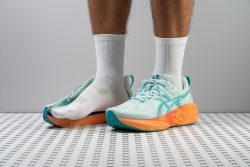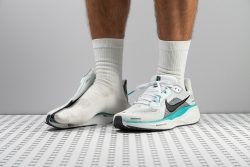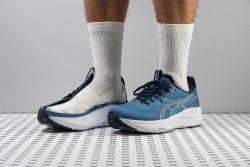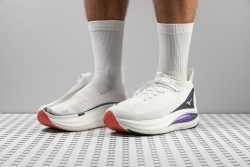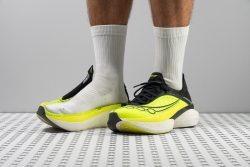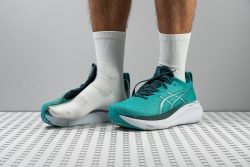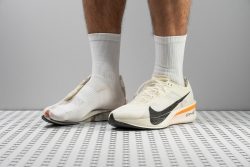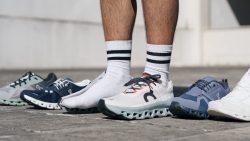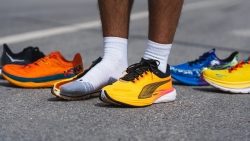7 Best Running Shoes For Women in 2025

We buy shoes ourselves. We earn commissions when you buy through us, at no extra cost. Why trust us
Physical strength aside, having the right pair of running shoes is the key ingredient in having an amazing run. For women, there are thousands of options available, which makes the selection part a bit of a drag.
But fret not, we curated a list that trims your options down to the best shoes from various categories. When we say we 'curated a list,' we meant we selected them by personally testing all these women’s running shoes to ensure they are worthy of choosing.
How we test running shoes for women
Our top picks for the best running shoes for women are NOT products of cherry-picking. First, we buy them with our own money. Second, we wear test them doing intervals, tempo runs, recovery runs, basically pushing through all the paces both on the roads and trails.
We also bring the shoes to our independent shoe testing lab to run different kinds of tests and assessments, including:
- Cutting each shoe into pieces for us to see what’s inside.
- Measuring the shoes' shock absorption, energy return, breathability, flexibility, traction, durability, etc.
- Comparing the data we collected to their average values so we can better interpret the results.
Best running shoes for women overall
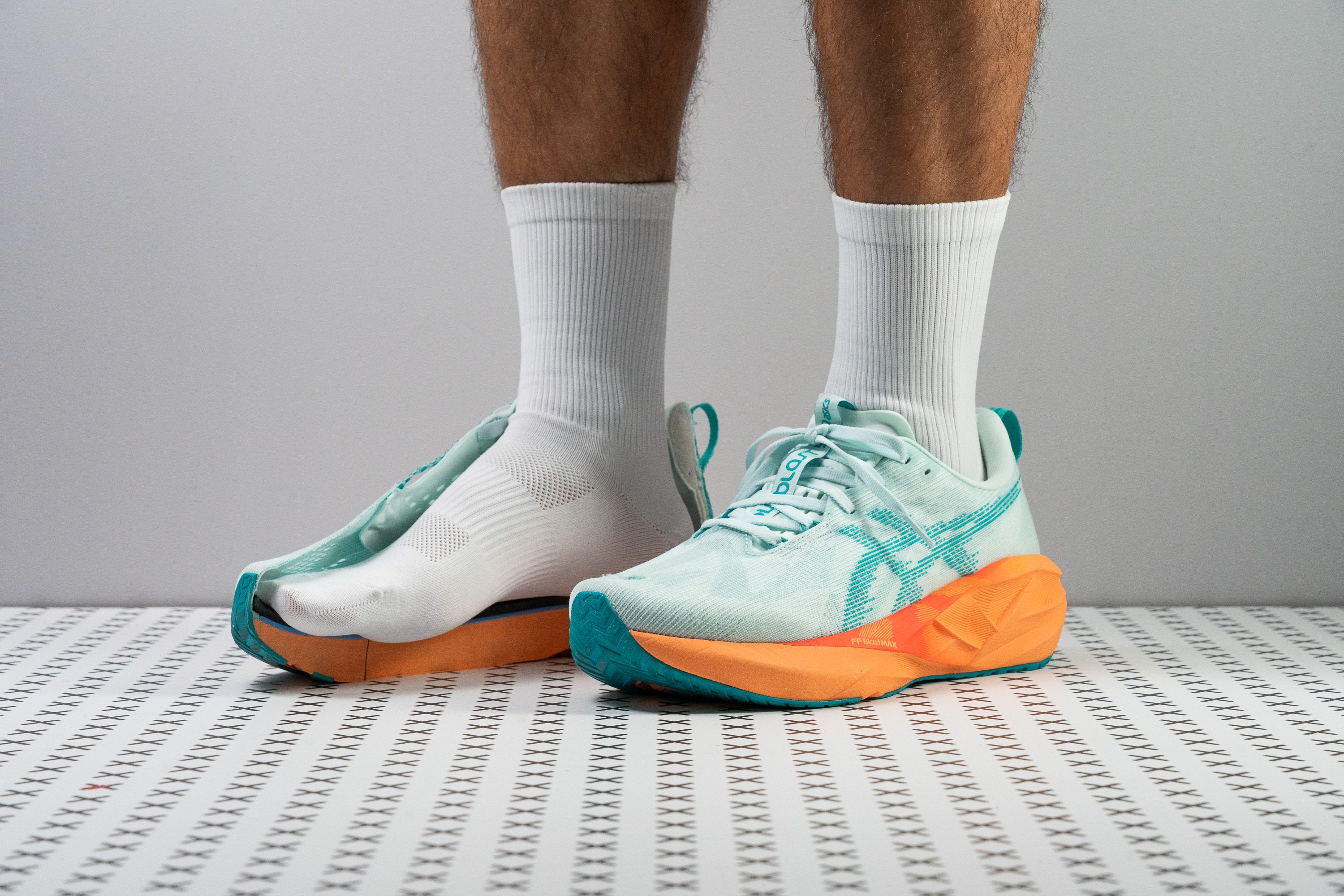























































What makes it the best?
After miles of pounding the pavement and hours of lab testing, we crowned the ASICS Novablast 5 as the top women’s running shoe. It’s a highly comfortable and supportive shoe that’s able to tackle any distance and other daily activities with ease. For all the versatility it offers, its £140 price tag is a pleasant surprise.
The Novablast 5 has an effortless aura to it that’s perfect for women on the go. Our scales reveal it’s only 9.0 oz (254g), right below the average running shoe despite its abundant cushioning. We found that it adapts to our movements easily, verified by our bend test when it emerged 32.2% more flexible than average.
The foam feels so gentle underfoot, and our durometer agrees with a rating 38.4% softer than average. We also measured the stack to be a massive 40.9/33.5 mm, ensuring our feet stayed protected against ground impact.
Amazingly, we never lost balance even if the shoe is both soft and tall. For enhanced stability, it offers a wide base similar to more supportive shoes. Our calliper confirms it’s a vast 122.3/97.6 mm vs. the 114.0/90.7 mm average forefoot and heel.
While already bouncy, we recommend more competitive ladies to find a more explosive shoe for record-breaking paces.
Pros
- Improved energy return with FF Blast MAX foam
- Plushiest foam in a Novablast yet
- Keeps the same price as v4
- Higher stack height for extra cushioning
- Enhanced flexibility
- Lighter than its predecessor
- Best Novablast ever for wide feet
- Exceptional weight-to-cushion balance
- Works for short, medium and long runs
Cons
- Breathability could be improved
- Toebox durability
- Toebox durability
Best daily training running shoes for women
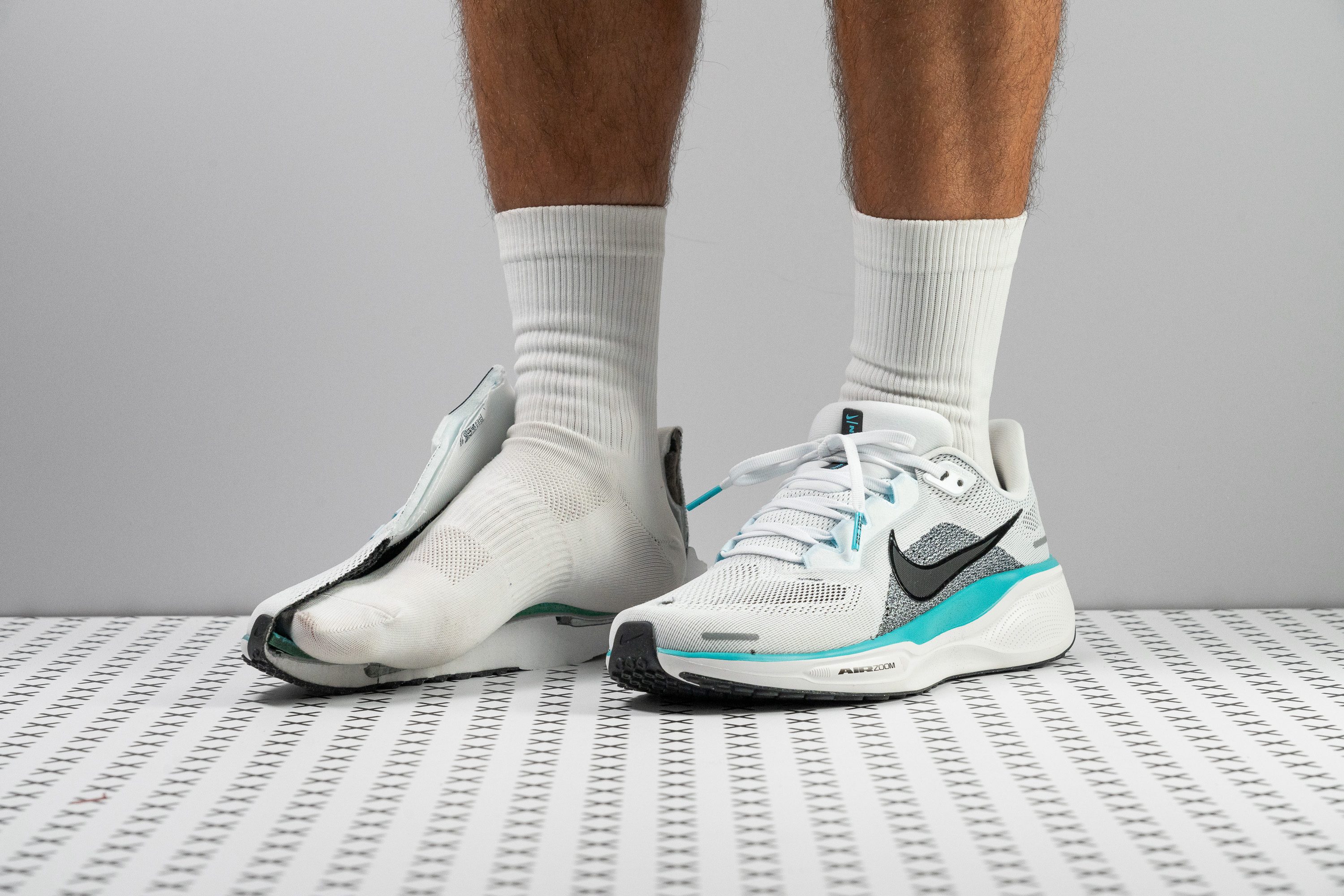




























































What makes it the best?
The Nike Pegasus 41 showed steady and reliable performance in our lab tests and runs, making it the top women’s choice for daily training. It brings a versatile and natural running experience that feels effortless to sustain, with an upper that’s suitable all year round.
The midsole is both grounded and comfortable—the former due to the low 22.2 mm forefoot and the latter due to the plush 15.8 HA ReactX foam. In addition, Pegasus 41 has two Air Zoom units which enhance energy return and remain the same over time. Altogether, the ride feels highly responsive and electric!
The Peg also feels agile since the midsole is easy to manoeuvre. Our bend test reveals it’s 32.9% more flexible than average, making it suitable for walking, gym workouts, and other errands. Its versatility is also highlighted through its upper, which scored a 4/5 in our breathability test. This rating makes it comfortable enough for all seasons.
What may be a dealbreaker to some women is its steep 11.4 mm drop that may strain the hips and knees. We recommend forefoot strikers to find shoes with a lower drop.
Pros
- Enhanced for heel strikers
- New ReactX foam!
- Improved breathability
- Plush upper
- Good durability
- Several stability enhancements
- Newly designed rocker and bevel
- Solid performance
- Superior lockdown
- Sustainable features
Cons
- Price increased by $10
- Worse than the v40 in cold temperatures
- Poor grip
- Poor grip
Best stability running shoes for women
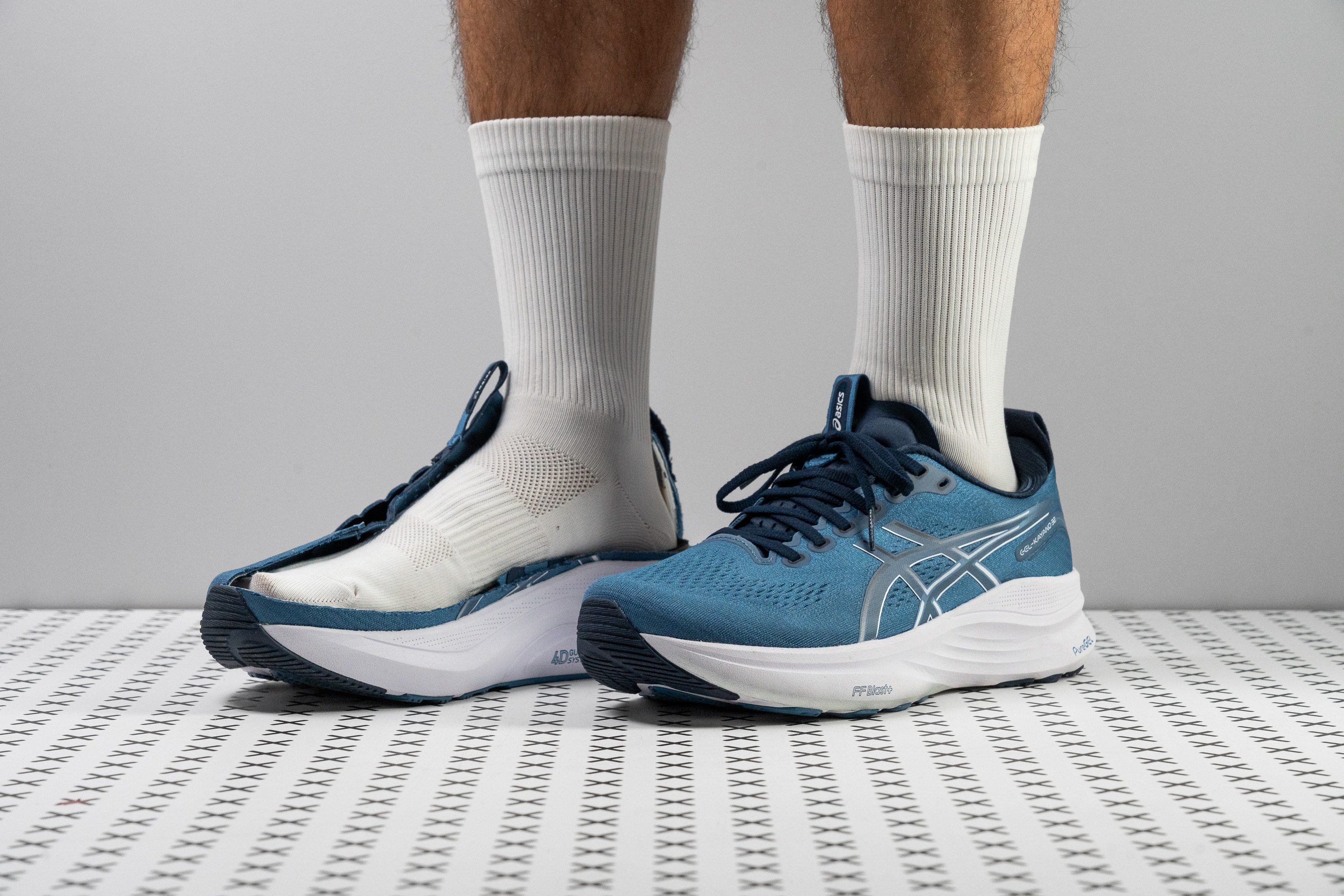













































What makes it the best?
Our runs with the ASICS Gel Kayano 32 verify it stays true to its core, delivering reliable support while ensuring a luxurious feel. It’s the type of shoe we can wear to run mindlessly and endlessly, with the 4D Guidance System reassuring our every stride. Even our lab results validate it’s the best stability shoe for women.
ASICS went all out in incorporating its most innovative stability elements into this shoe while maintaining a natural feel. It features midsole sidewalls, arch support, an expansive base, and the 4D Guidance System. Our calliper confirms it’s a wide 119.8/97.2 mm, which offsets any potential imbalances during our runs.
Comfort still dominates the Gel Kayano 32 experience with its generous 39.9/30.6 mm stack. Additionally, its shock absorption stands out with high ratings of 133 SA and 116 SA in the heel and forefoot, respectively. With above-average scores, it’s able to significantly reduce the impact on our legs.
The Gel Kayano 32’s performance is a true testament that we can’t have it all. While comfort and support dominate our runs, they lack excitement and energy return. Those seeking a responsive ride are better off elsewhere.
Pros
- Amazing shock absorption
- Plush and breathable upper
- Made to last
- Dependable for most pronators
- Heavy-duty outsole with excellent grip
- Stable as a table
- Pillow-soft heel padding
- Improved fit
- Excellent build quality
Cons
- Not for soft-foam lovers
- Bad energy return
- Overpriced in Europe
Women's running shoes with the best shock absorption
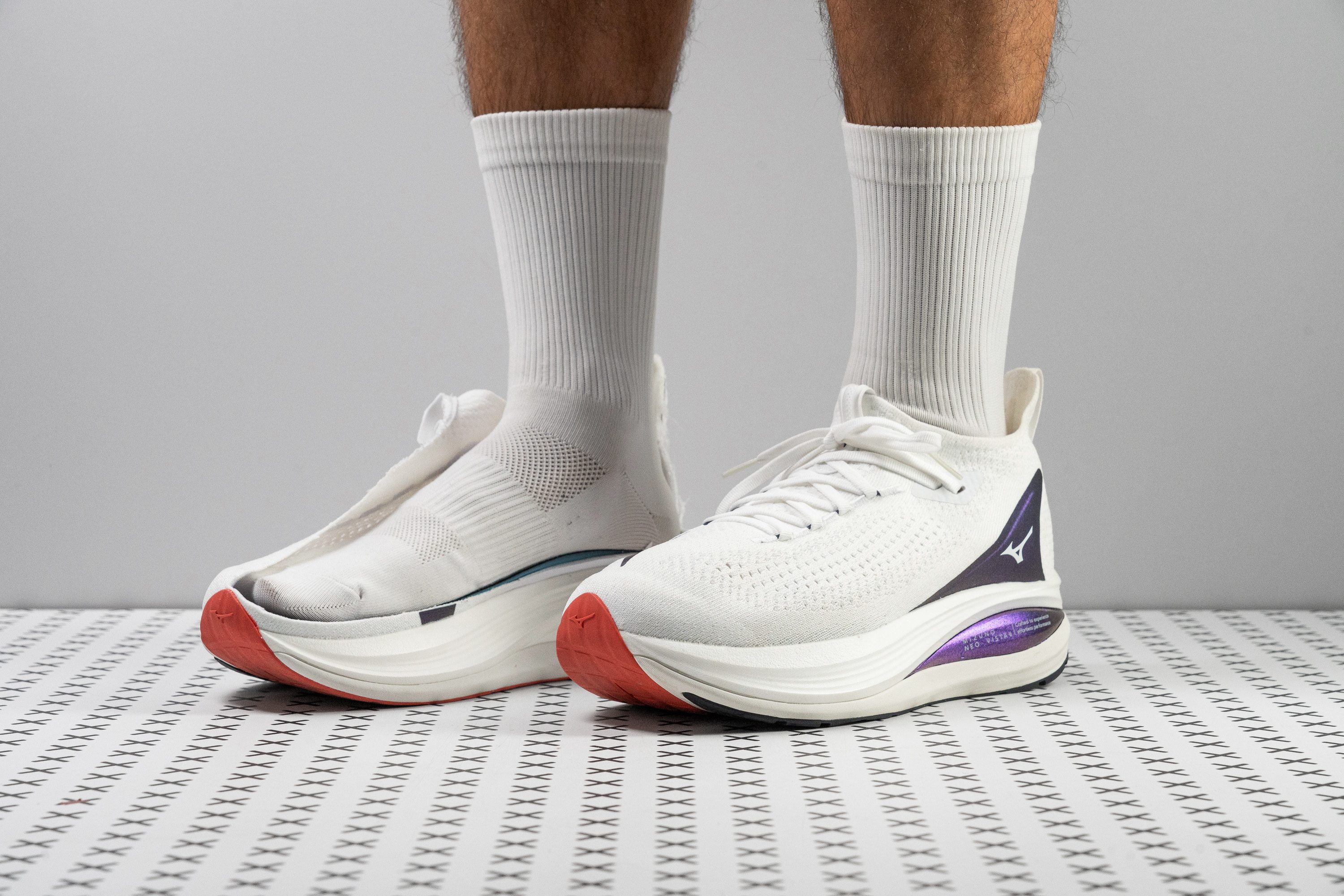
















































What makes it the best?
We wear-tested and sliced the best women’s running shoes in the lab and found the Mizuno Neo Vista 2 to have top-tier shock absorption. It delivers much-needed TLC for any distance and shines best on days we need to recover. Plus, the outsole can last countless miles!
Having the Neo Vista 2 underfoot completely erases the ground feel since there’s so much foam in between our feet and the ground. To be more accurate, our calliper measurements show a 46.0/37.5 mm stack—the forefoot being much higher than many other shoes’ heels.
Its luxurious and gentle touch can be attributed to its high level of shock absorption, significantly 170 SA in the heel and 137 SA in the forefoot. Every landing is pure bliss, we felt like we could keep running forever in this pair!
Even the outsole can support endless miles. Our Dremel tool only managed to dent the rubber by 0.6 mm, which is highly impressive given the 1.0 mm lab average. Its reassuring performance erased any doubts of premature wear.
Unfortunately, the cushion’s high sink-in feel may compromise stability, so we don’t recommend this pair to women who need extra support.
Pros
- Massive stack height
- Super-plush Enerzy NXT foam
- Perfect for long runs
- Lightweight for its huge size
- Good durability
- Breathable knit upper
- Roomy toebox height
- Insanely fun!
Cons
- Not enough energy return
- Price hike feels unjustified
- Not stable for heel strikers
Women's running shoes with the best energy return
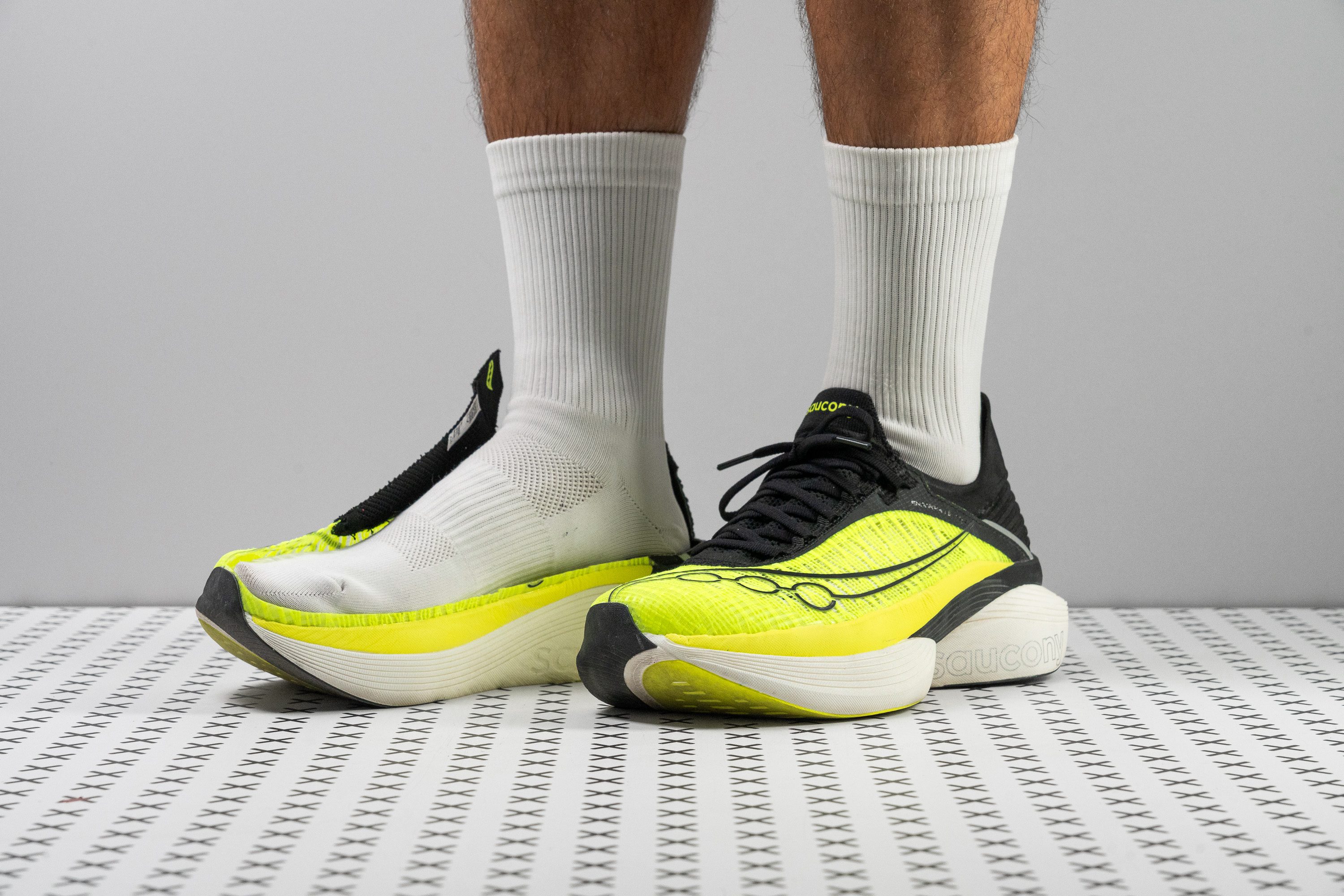















































What makes it the best?
The Saucony Endorphin Elite 2 electrified our runs with its streamlined build, energetic midsole, and unmatched impact protection. Slicing the best women’s running shoes in half in our lab confirms that they offer top-level energy return.
Testing the shoe’s layers confirmed its supershoe status for ladies. We discovered a bouncy IncrediRUN foam in the lab with a spoon-shaped carbon plate nestled in between. We measured the cushion’s energy return in the lab, and our jaws dropped: EE2 leads all the shoes we’ve tested so far in terms of responsiveness, with 80.6% in the heel and an even higher 82.1% in the forefoot, filling our runs with excitement.
Wearing the EE2 made us very swift and agile. Our scale confirms what we felt: this trainer has a sleek build for lighter strides, weighing only 6.9 oz (197g), 25.7% below average.
With every solid toeoff, a plush cushion awaits. Its solid stack height of 39.9/32.4 mm ensures we never run out of protection. Plus, the cushion itself returned high shock absorption scores in the lab: 157 SA in the heel and 123 SA in the forefoot, validating the reduced leg strain we felt.
However, its tapered toebox is concerning. We can’t recommend this pair to those with wide feet, and for distances like marathons and ultras, which may lead to swelling.
Pros
- Record-breaking energy return
- Ultra-plush foam
- Fantastic shock absorption
- Addictively bouncy and fun feel
- Ideal for the marathon distance
- Durable and breathable upper
- Improved lockdown with knit tongue
- Stack height maxes out the legal limit
- Explosive, forward-driving ride
Cons
- A touch heavy for being an elite supershoe
- Budget-crushing price
- Lateral stability is extremely bad
- Lacks specific support for heel strikers
Women's running shoes with the best traction
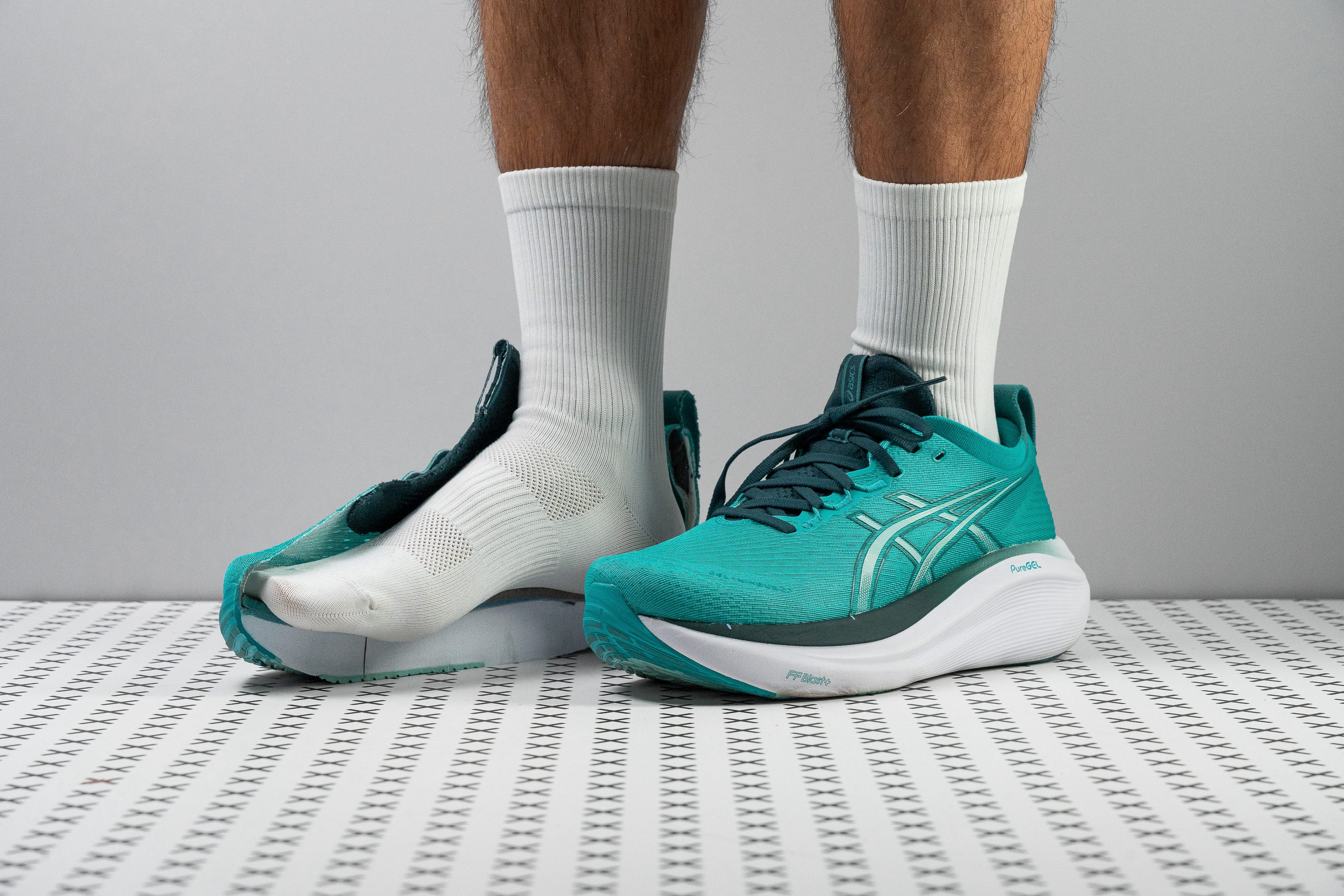


















































What makes it the best?
The ASICS Gel Nimbus 27 ensures superior control over our strides, regardless of surface conditions, because of the top-level traction it offers among women’s running shoes. Besides its gritty bite, our lab results reveal it’s a shock-absorbing powerhouse with a stable feel and a breathable upper.
We tested the Hybrid ASICSGRIP rubber and it impressed with a high friction score of 0.84, 82.6% stronger than average. At this level, it can handle the most slippery roads with ease. Moreover, we measured its landing zone at a wide 119.5/99.8 mm. The spacious base ensures surefootedness even as fatigue sets in.
In order to prevent early leg tiredness, the highly-cushioned midsole reduced impact significantly. With solid scores of 136 SA in our shock absorption test for both the heel and forefoot, Nimbus 27 acted as an effective buffer.
The gentle touch of the jacquard mesh upper is unlike anything we've experienced before. Testing the shoe was a delight because we had zero instances of overheating. Our breathability tests confirm its exceptional ventilation, earning a commendable 4/5 rating.
Unfortunately, the Gel Nimbus 27 doesn’t deliver the natural ride that some women are seeking. We rated it a high torsional rigidity of 5/5, which feels similar to carbon-plated shoes, albeit without the same energy return.
Pros
- Even more foam underfoot!
- Premium-feel, breathable upper
- Fantastic stability
- Improved toebox with extra wiggle room
- Flexible knit tongue
- True maximalist comfort for recovery runs
- Amazing heel lockdown
- Top-tier grip
- Top-tier grip
Cons
- Feels bulky and heavy
- Minor price increase
- Lacks energy return
- Minimal outsole coverage
Best race running shoes for women
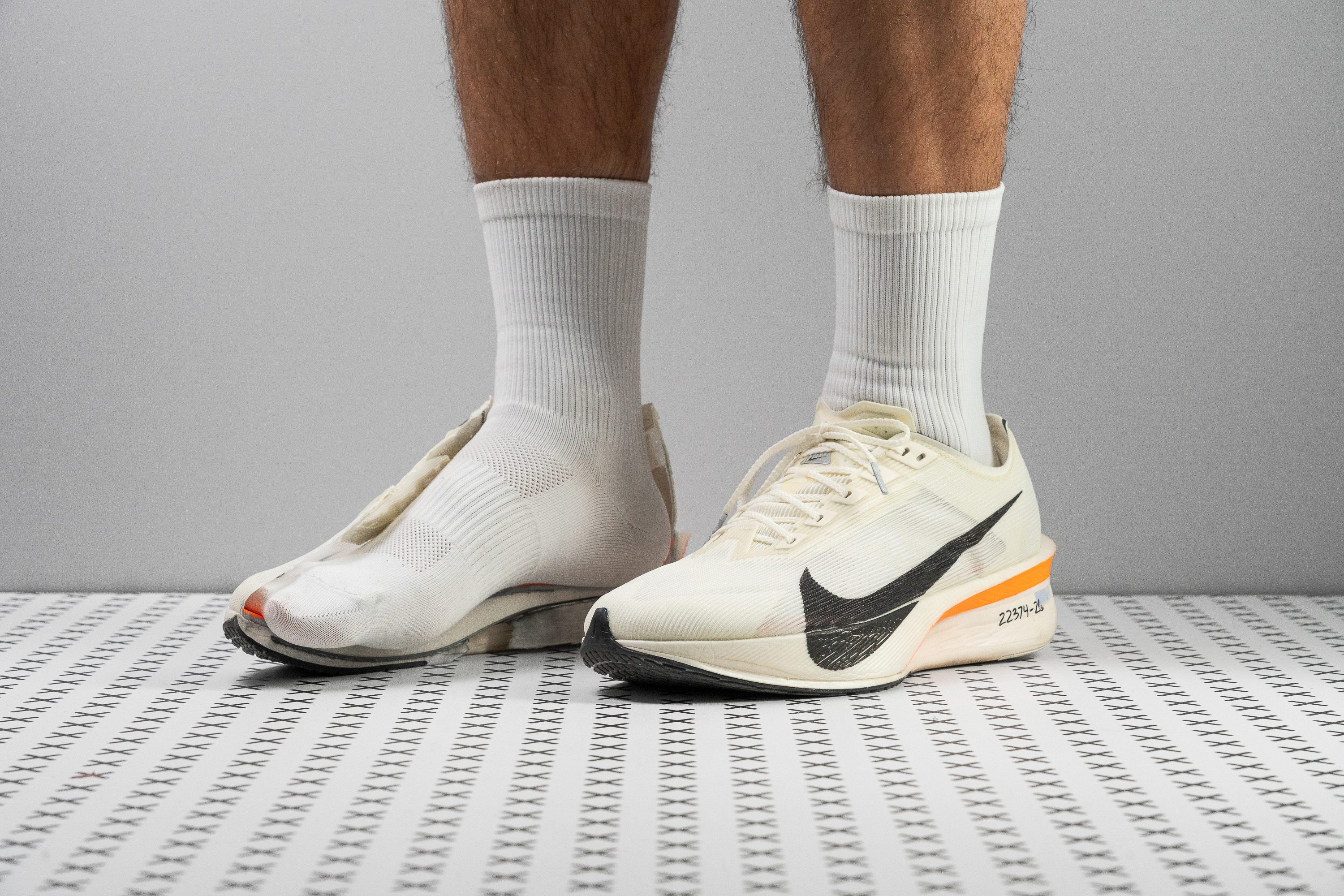























































What makes it the best?
After rigorous lab tests and runs, we found the Nike Vaporfly 4 as the strongest race contender for fierce lady runners. Its solid combination of swiftness, lightness, and comfort took us to the finish line at a record-breaking pace. Its unmatched energy return took our breath away.
The Vaporfly 4 delivers otherworldly speed through its stiff and uniquely spoon-shaped carbon FlyPlate, which enables faster and smoother turnover. We’re astonished by how it doesn’t feel too harsh on foot, thanks to the plush and energetic ZoomX foam over the plate that relieves muscle strain and delivers powerful energy return. It feels easy to keep running since each landing is met with a plush 19.9 HA midsole.
Keeping its name close to our hearts, Vaporfly 4 made us fly so effortlessly since it never burdened us with its weight. Our scales reveal a mere 5.9 oz (166g), one of the lightest we’ve seen in the lab.
Amplifying its airiness is the pleasantly breathable upper, which scored a remarkable 4/5 in our smoke test. This boosted our comfort and confidence since we didn’t have to worry about blisters, no matter how long or hot our run was.
However, women who strike from the rear will feel unstable in VF4’s narrow heel. We recommend that heel-strikers find a racer more suited to their biomechanics.
Pros
- 13% lighter than the Vaporfly 3
- Awesome for 5K, 10K and 21K races
- Full ZoomX midsole
- Spring-loaded carbon-fibre Flyplate
- Fantastic lockdown with premium laces
- Moderate rocker for a more natural ride
- Improved perforated, removable insole
- Better rubber coverage in the forefoot
- Gets improvements from the Alphafly 3
- Great upper featuring breathability and durability
Cons
- Less ideal for marathon racing
- Still lacks the snappy feel of the Vaporfly 1&2
- Narrow midfoot and heel limit stability
What makes women’s shoes different from men’s?
Some brands make running shoes for women and for men to accommodate the anatomical differences between their feet. However, even though it’s said that women’s feet are more triangular (with narrower heels) and men’s are more rectangular, in many cases, women’s and men’s shoes are not that different.
In most cases, it’s the upper that’s given more volume or made tighter to create the feeling of a narrower/wider fit while the cast of the shoe remains the same.
There are 4 things that differentiate women’s running shoes from men's:
- Sizes
- Width industry labels
- Heel drop and/or stack heights
- Shape (width) and other shoe details
- Colorways
| If you’re a woman thinking of wearing running shoes in men’s sizes and want to learn all about it, please read our guide Understanding the differences in men's and women's running shoes. As a general rule, the difference between men's and women's sizes is 1.5 sizes. If you're US size 9 in women's shoes, you would need 7.5 in men's. |
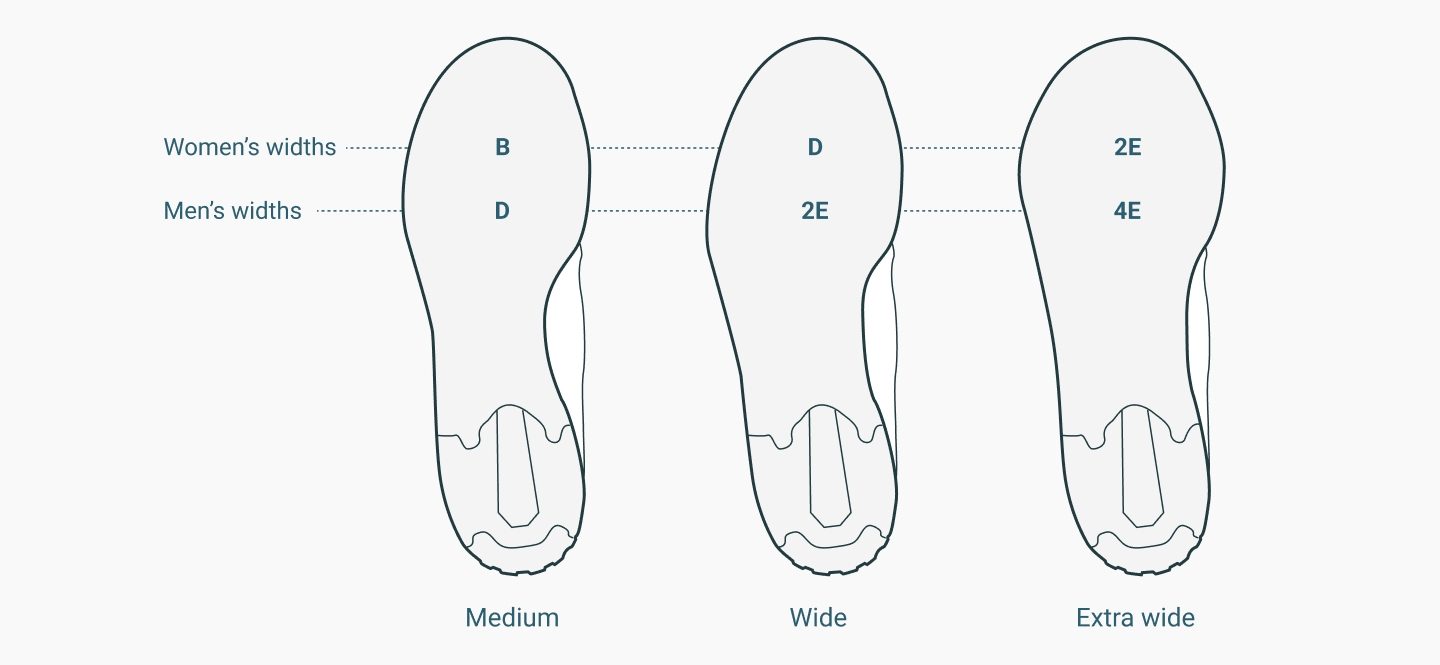
Women’s width options are marked as B for medium, D for wide, and 2E for extra wide. It can be somewhat confusing because D also marks men’s medium, and 2E marks men’s wide.
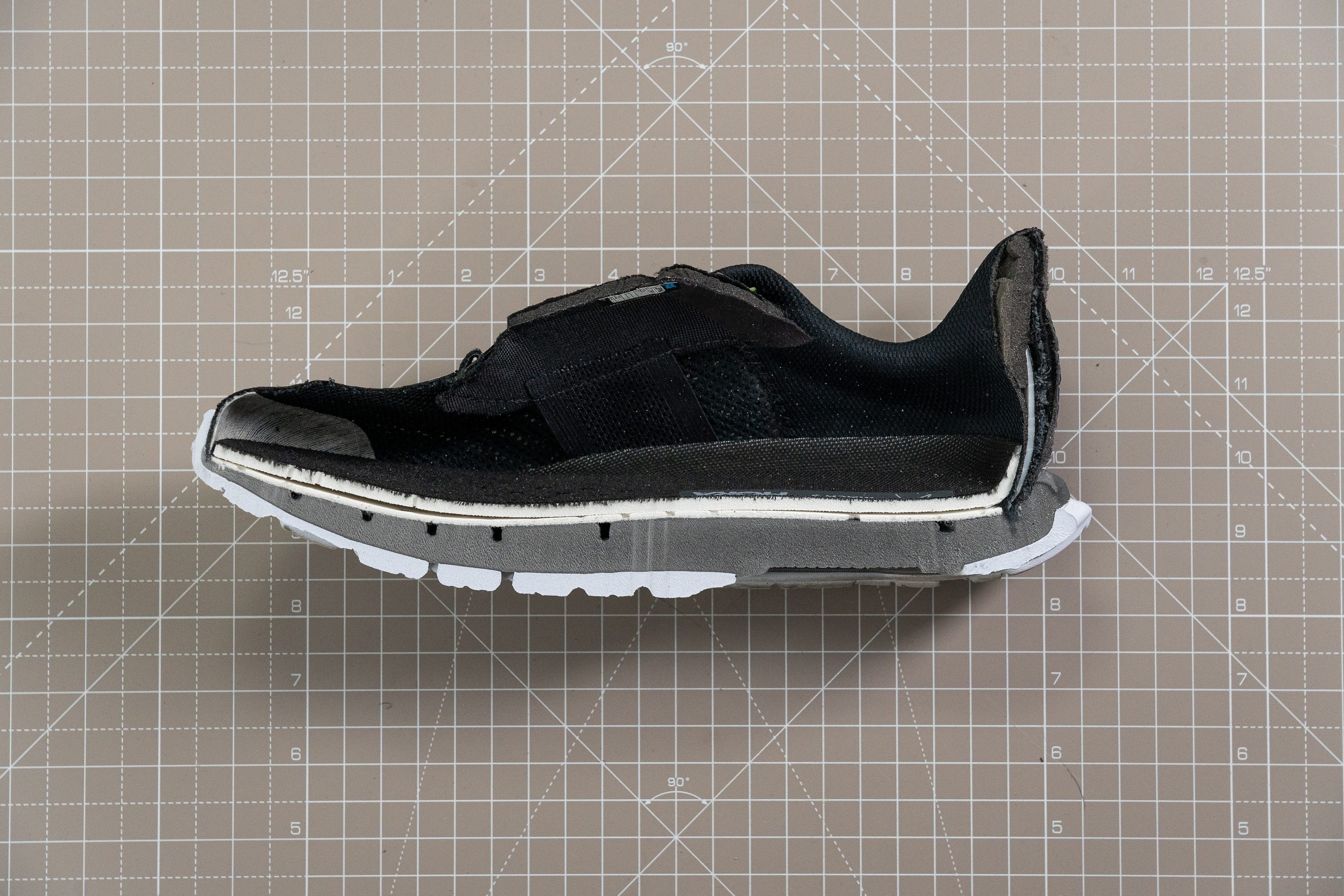
Some brands release women’s shoes with different stack heights and heel drops from the men’s versions. This can go both ways (higher or lower stacks). For example, Hoka Mach 5 was released with 29mm at the heel for men and 27mm at the heel for women, and Kayano 29 has 24mm at the heel for women and 25mm for men (all numbers given according to the brands’ specifications, not our lab measurements).
In some older Pegasus models, Nike customised the air chamber pressure to 15 PSI for women and 20 PSI for men.
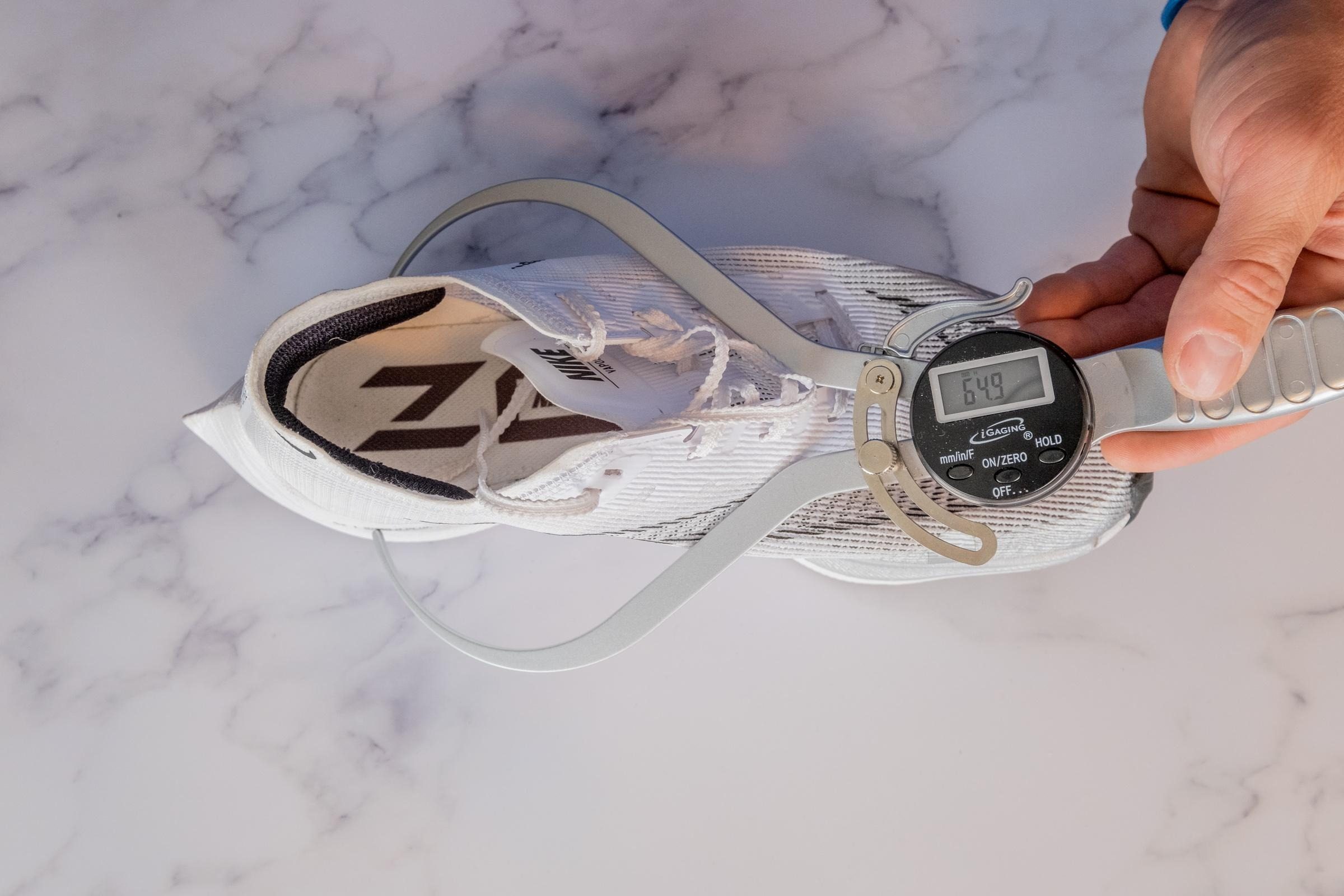
Women’s running shoes are said to be narrower at the heel and wider at the toebox. However, we should have 2 things in our mind:
- being narrower or wider is not always what we think it is. The whole cast is not always changed or made narrower/wider, but it’s the upper that plays a crucial role here. It’s given more or less volume meaning the shoe feels wider or narrower. Especially when you go from D to 2E.
- It actually depends a lot on the brand and what they decide to do. Some runners feel no difference when wearing the shoe in women’s and men’s variants. Saysh, for example, a women's-shoe-only brand, says they make shoes for female feet: narrower heel and a standard forefoot. Some brands explicitly say they are creating gender-neutral shoes, which means there’s no difference.
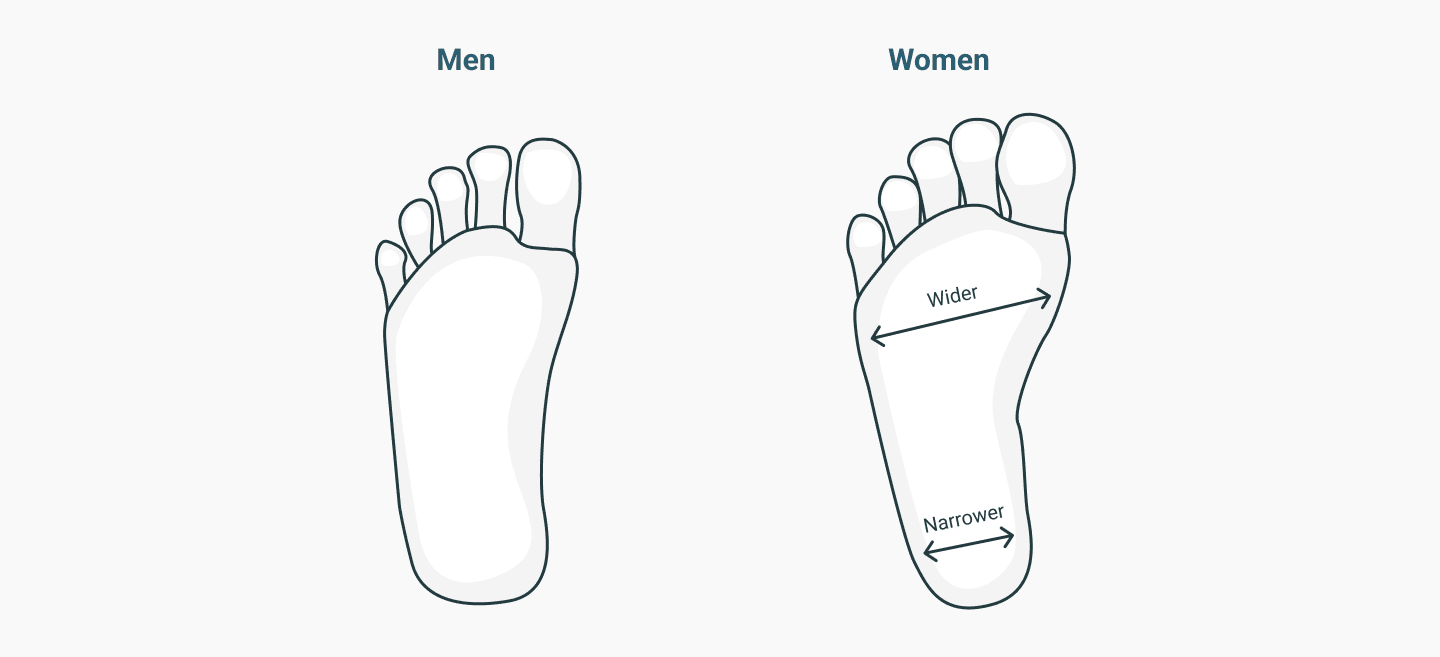
If you’re looking into brands and models that make women-specific running shoes, here are a few options: Saysh, Lululemon’s Blisfeel collection, and Puma’s Run XX Nitro 2. Finally, women’s options often have different colorways, which is often an incentive for runners to choose the opposite gender’s option!
When it comes to shoe names and shoe boxes, W is the symbol to look for. Or women, or a lady symbol like the one we see on the toilet doors.

What’s the deal with unisex running shoes?
Some brands create unisex running shoes. They may tag them as “all gender”, “gender neutral” or “unisex”. These running shoes are a no-brainer, no need to question how they are different, if at all, because they are not.
If you’re looking for unisex running shoes, look for both the women’s and men’s “toilet” symbol or the sizes listed in the women’s and men’s charts.
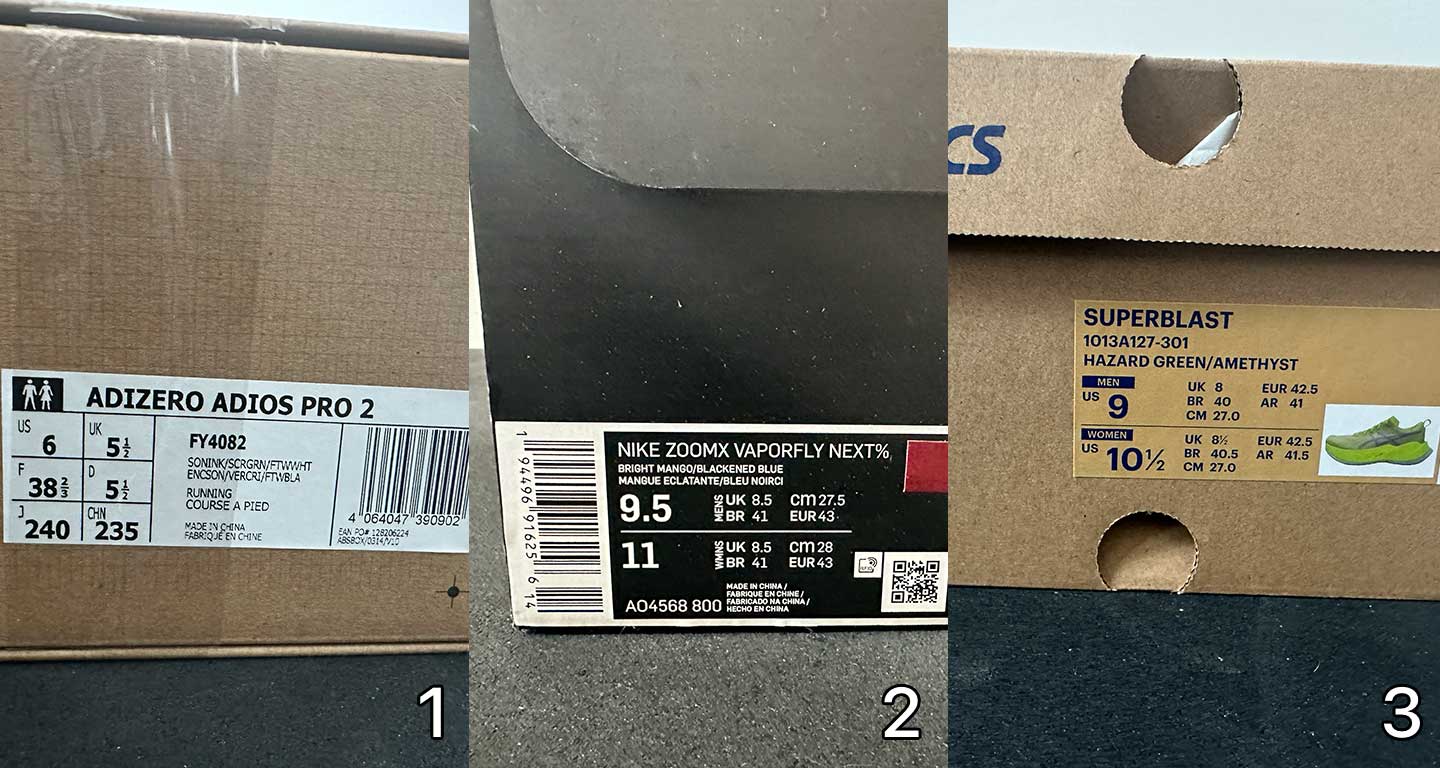
Here are some unisex running shoes in case you're interested:
How to choose the best running shoe for you
It can be overwhelming to take everything into account. However, we recommend spending more time now on figuring things out, because that will enhance your chances of finding the perfect running shoe dramatically.
1: choose the terrain
There are 2 options: road running shoes and trail running shoes. Their names are self explanatory, so if you plan to run on concrete, asphalt, hard surfaces around the city, choose road shoes. If you plan to hit the trails, hills, mountains, or even a single track in your closest park, choose trail shoes.
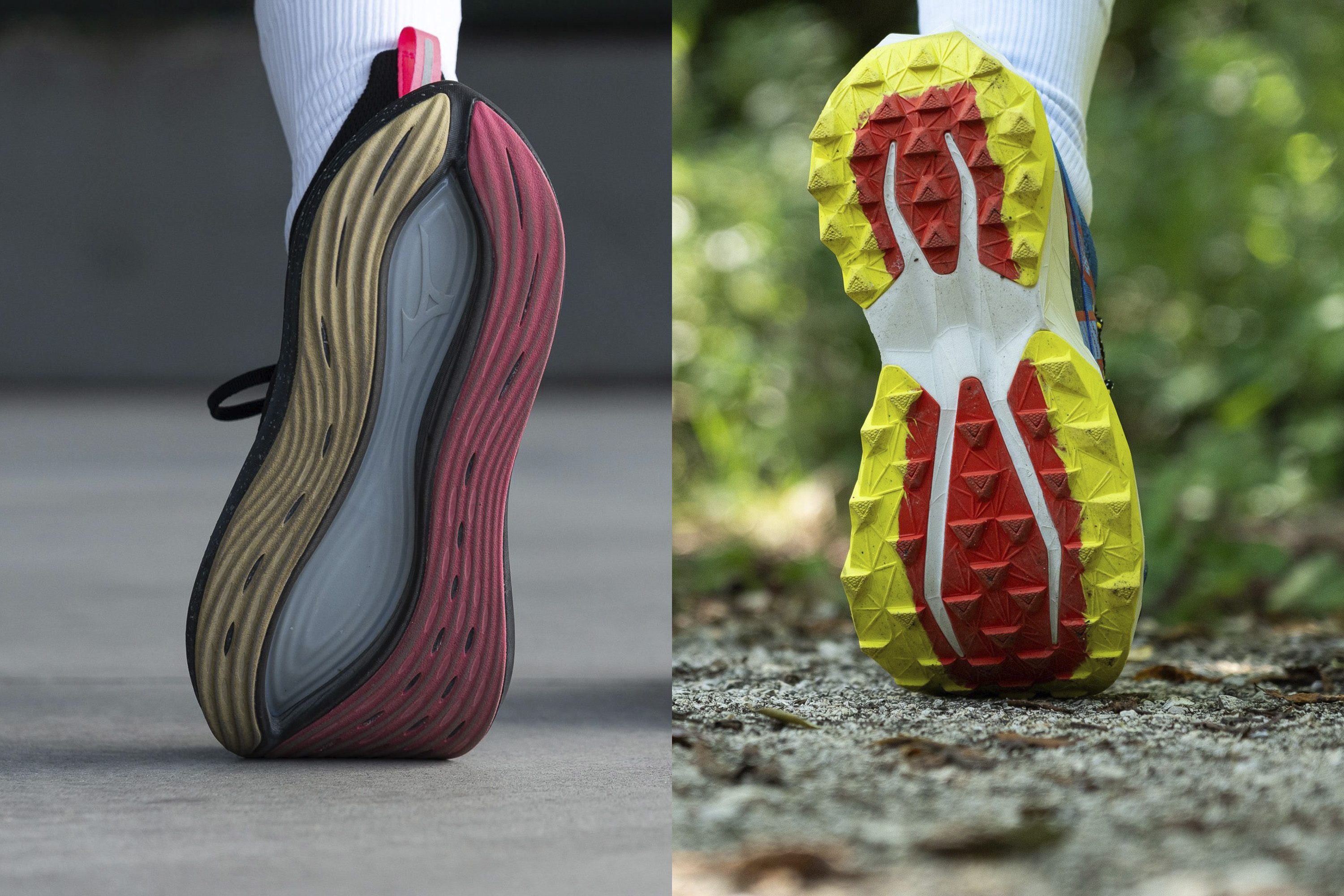
There is a hybrid category: running shoes that are great for a bit of both. They excel at road-to-trail adventures. We cover them in the trail shoe section where you can choose “light terrain” filter, and definitely skip “moderate” and “technical” when looking for a hybrid shoe.
2: decide on the purpose (pace)
There are 3 big running shoe categories that depend on the pace:
- Daily running shoes, which are used for (guess what) daily runs. These runs are usually easy, light, they entail jogging, recovery runs, basically everything at a slower pace. This does not mean they have to be short, we also have LSD or long slow distance, runs meant for building up the mileage. They are also done in daily trainers.
- Tempo running shoes or shoes for speedwork are used for tempo runs. The are lighter and faster than daily running shoes and they often overlap with race shoes.
- Race running shoes or competition running shoes which are, as the name suggests, used for races! They are often expensive and not durable, so runners keep them for the race day only and do not train in them.
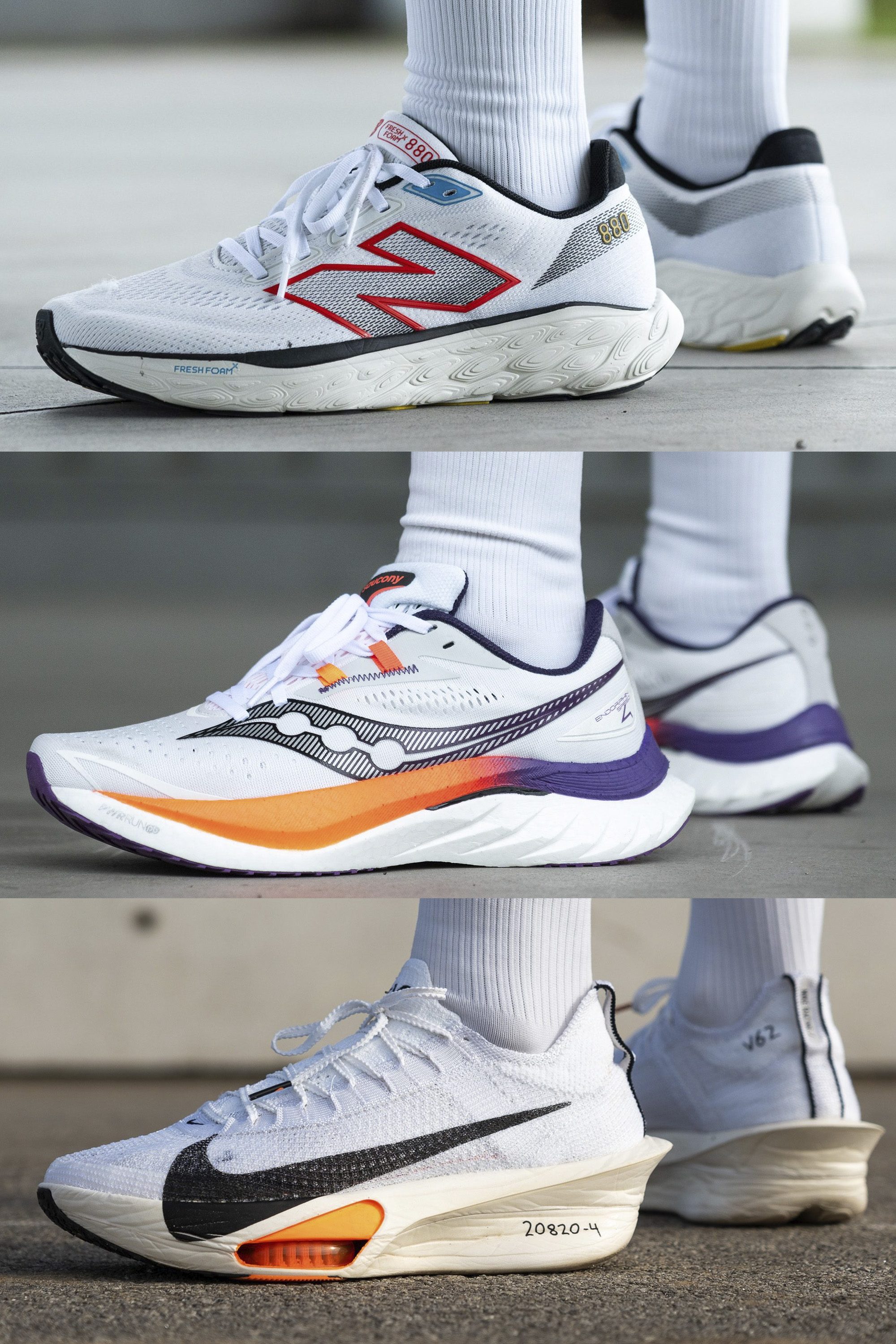
Here are some of the pronounced features of these 3 running shoe groups:
|
Durable |
Durability varies |
The least durable |
|
Comfortable |
Design often allows them to be used for races as well |
Aggressive design |
|
Shock absorption varies |
Moderate to high shock absorption |
Usually very high shock absorption |
|
Energy return varies |
Moderate or high energy return |
Usually very high energy return |
|
Very padded |
Somewhat padded |
Usually not padded |
|
Neutral or stability |
Most of them are neutral |
Neutral only |
|
Very stable |
Quite stable |
Often high and unstable |
|
Can be very affordable |
Mid-range price |
The most expensive |
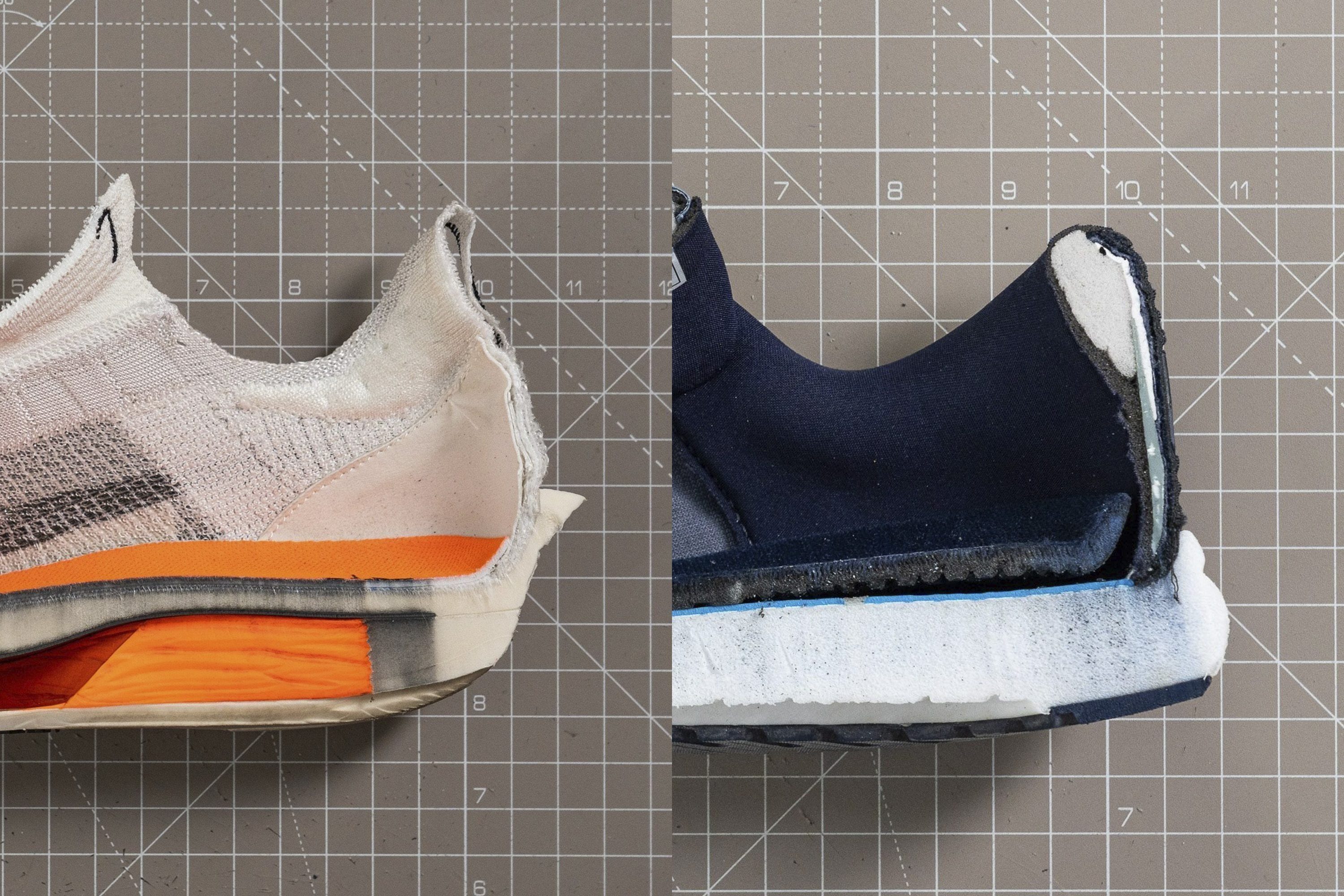
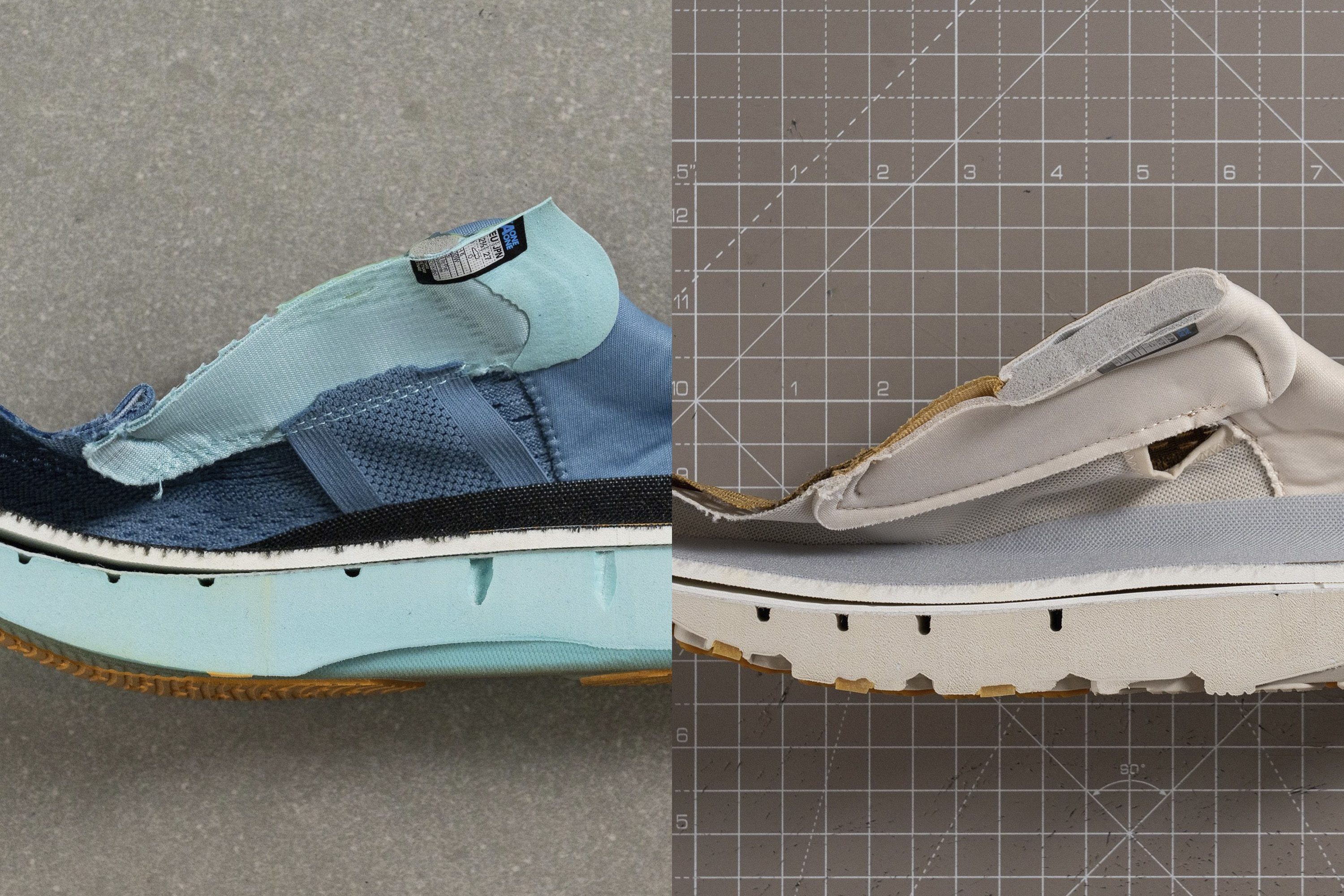
3: figure out your pronation
Skip this section if you already know whether you’re an overpronator, supinator, or have neutral pronation.

Pronation is a completely natural and normal movement, and it happens when running when our ankle rolls inward once we land on the ground. In most cases, the ankle rolls inward (overpronation). Other runners have a neutral pronation or supination/underpronation (their ankles roll outward).
Knowing pronation matters because of the shoe choices:
- Overpronators usually wear stability shoes. Most of the stability shoes are meant for daily runs
- Neutral pronators and supinators wear neutral running shoes. All race shoes are neutral shoes, and in the world of tempo shoes, the majority are neutral
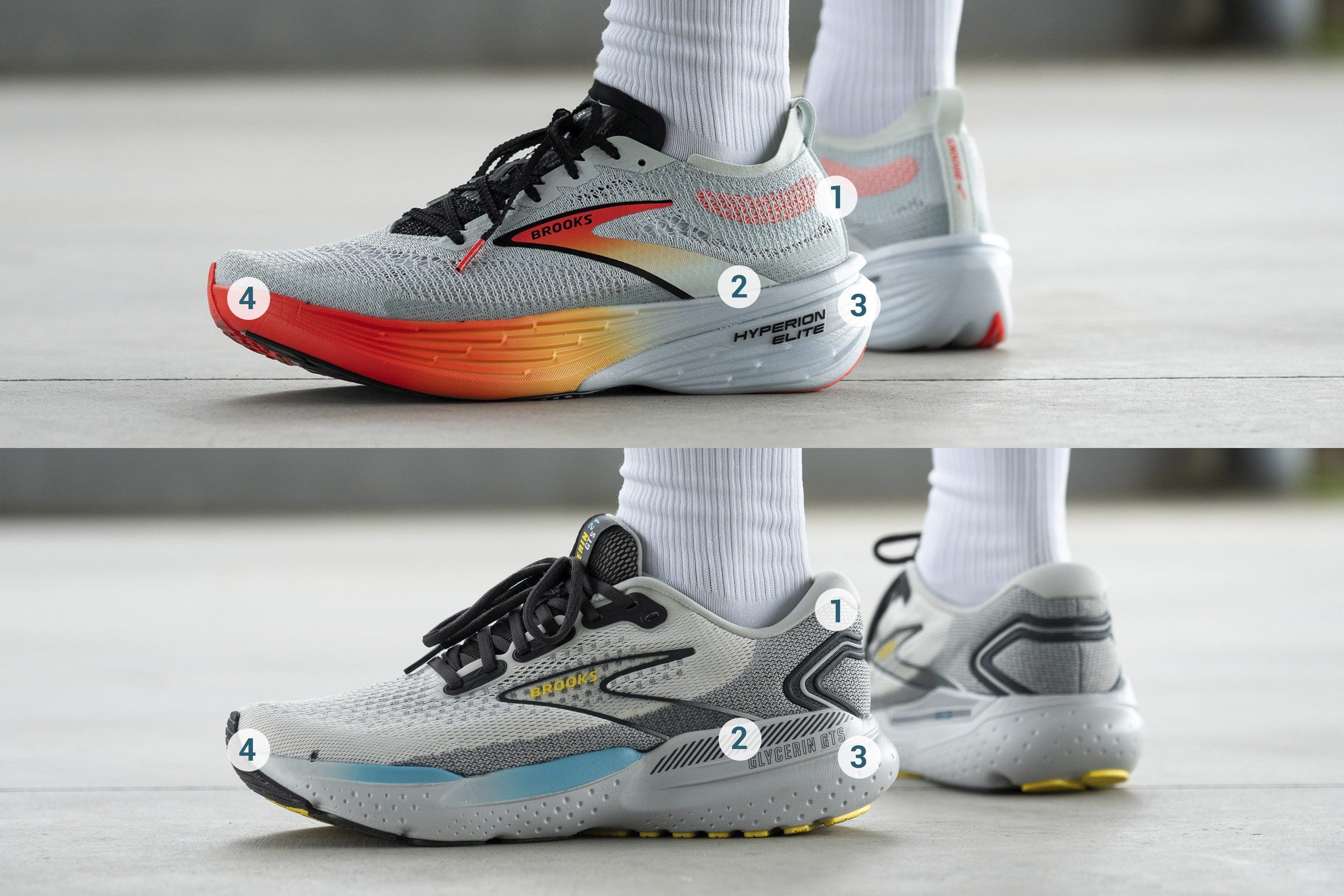 Here, we see a (neutral) race shoe above a stability daily trainer:
Here, we see a (neutral) race shoe above a stability daily trainer:
1) soft sock-like heel vs a padded heel with a plastic heel counter
2) no side walls vs. GuideRails present
3) no heel flare vs. a present heel flare
4) less ground contact vs. more ground contact outsole
This is a big step when choosing running shoes and it’s important to nail it! Stability shoes feature special technologies for extra stabilisation and support, while neutral shoes tend to be more flexible, lighter and cheaper.
4: figure out your foot strike
When running, we land on the forefoot, on the midfoot, or on the heel. That’s why running shoes are usually made for forefoot/midfoot strikers and/or for heel strikers. Knowing your foot strike is important because then you can look for more cushioning in the area where you land.
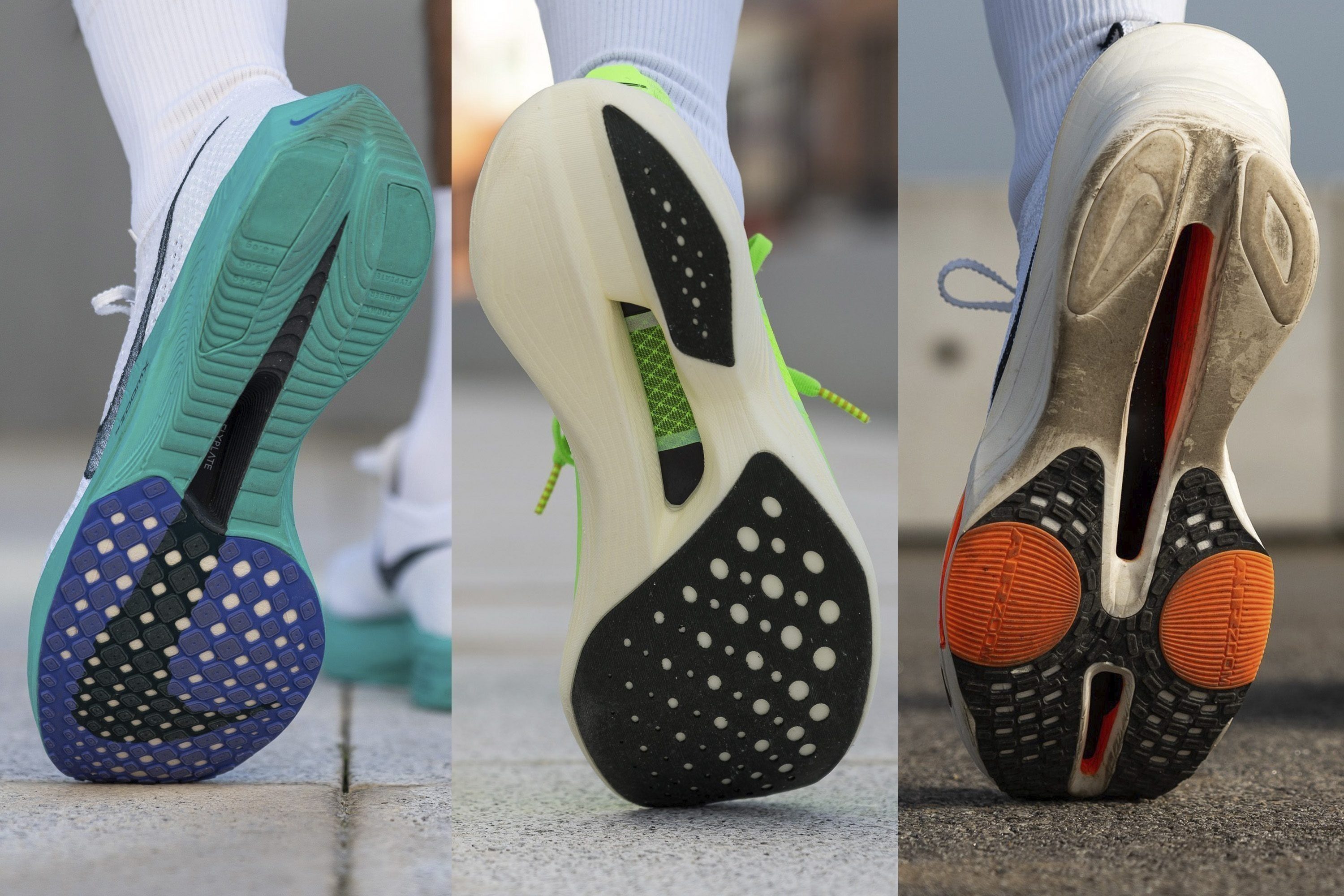
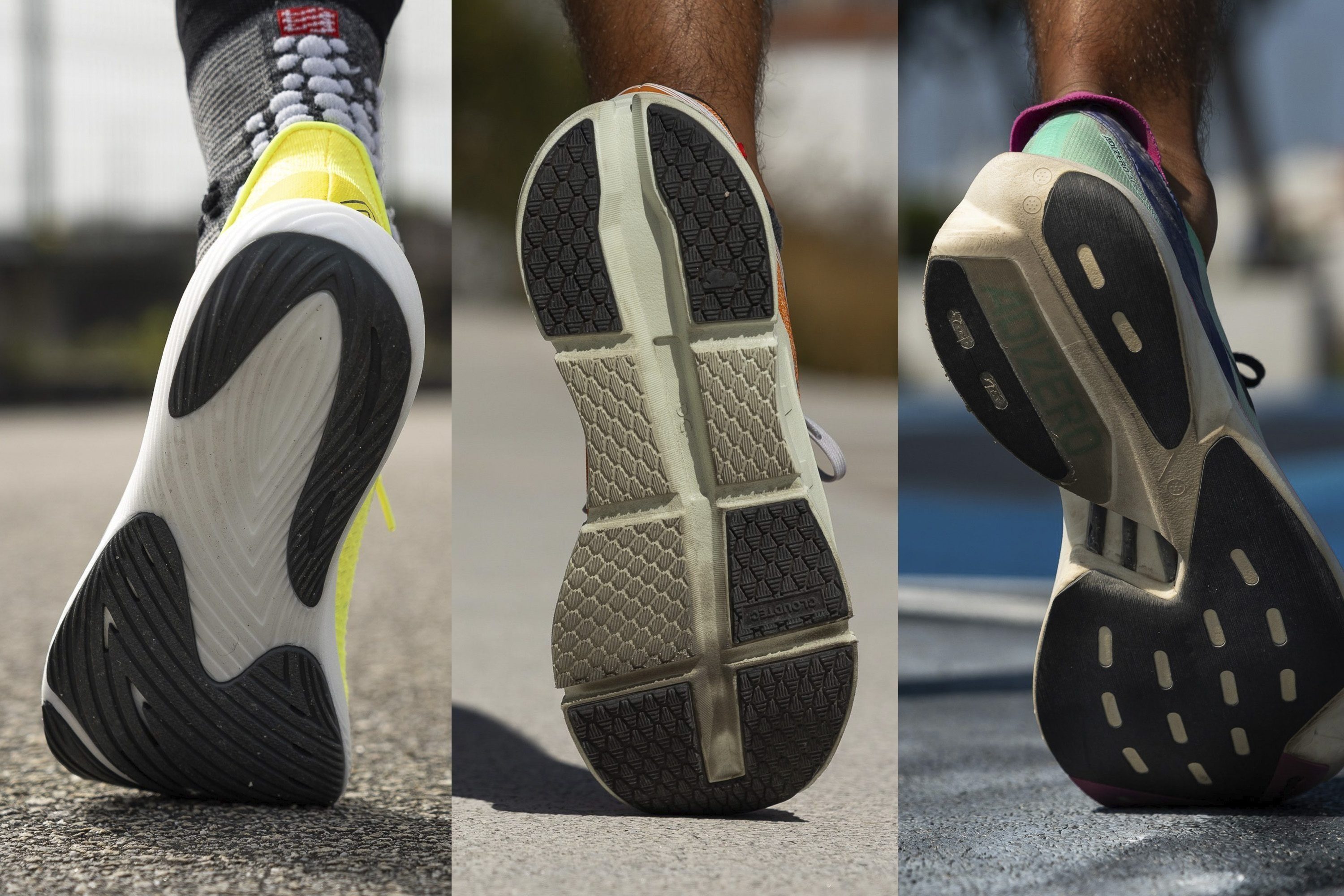
And, looking at the outsoles, you can look for running shoes that also feature rubber outsole where you land. Some race shoes place rubber only at the forefoot or add some smaller pieces to the heel. As a complete opposite, there are running shoes with full-length rubber outsole. The majority is somewhere in the middle.
|
When it comes to the foot strike, we went down the rabbit hole while writing our guide Foot Strike: The Ultimate Guide. Read it if you want to learn more! |
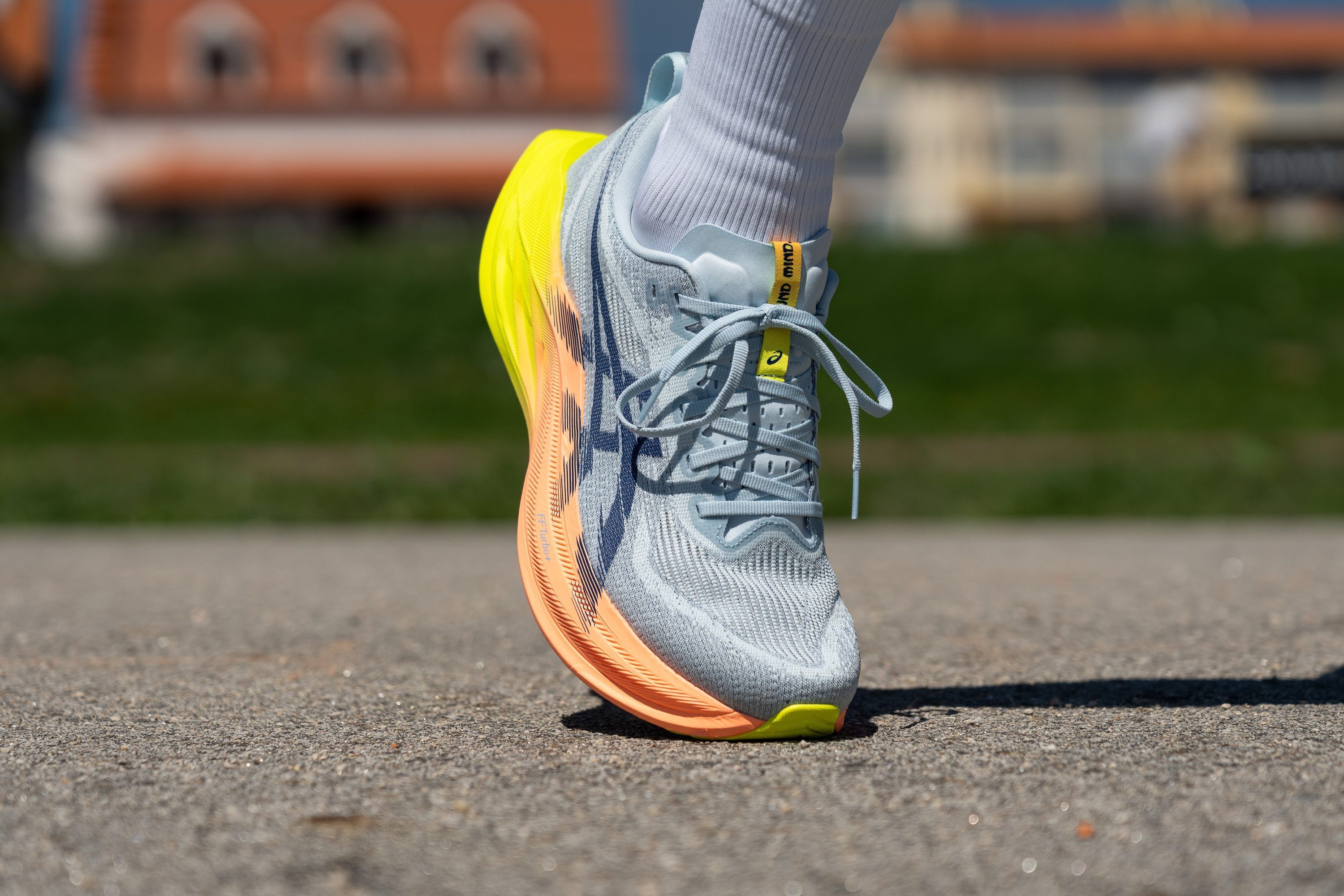
5: focus on your priorities
Running shoes have many features and, depending on your previous experience with the shoes and your current form and maybe even injuries, you might want to prioritise different things. Here, we’ll list many of them and dig deeper into the most important ones further down.
You might care about:
- Shock absorption is one of the main factors that make running shoes comfortable. It tells us how much of an impact the shoe can take, saving runners' legs from the full-blown, harsh impact forces.
- Energy return tells us whether the running shoe is propulsive, whether it pushes the runner forward, and whether it is bouncy! Basically, we measure how efficiently the midsole recovers from being squished during the landing. A lively ride means that the shoe has a great energy return and that the midsole does some of the work instead of the runner.
- Stack heights or how high off the ground your feet are if you already know whether you want some ground feel (lower stack heights) or no ground feel and as much cushioning as possible (high stack heights).
- Heel-to-toe drop if you previously experienced or are currently experiencing muscle strains or injuries. And if you never run before, in that case, best to choose a higher heel drop.
- Pronation if you have flat feet or you overpronate noticeably.
- Foot strike because forefoot/midfoot strikers have different shoe needs than heel strikers.
- Durability of running shoes if you already have a bad experience with shoes lasting nearly not long enough or if you know which part of the shoe you’ll expose to the beating (toebox or outsole).
- Breathability if you plan to run in very hot weather, if you have sweaty feet, or if you need shoes that trap the heat because you prefer running in cold weather.
- Stability of running shoes if you want to be extra safe, you’re pregnant, you love cornering and running over demanding terrain, etc.
- Toebox width - something that runners usually care about if they have a wider toe box.
- Traction because noone wants to slip and slide on wet surfaces or when cornering.
Now, we will explain all of these features, back them up with numbers, and give recommendations depending on your preferences.
Shock absorption in running shoes for women
While shock absorption comes in a range of values, you may think that the higher is always better. It may seem so, however, even moderate shock absorption is often a great option for average runners who are fit (not considered heavy runners) and who log average miles. If you wall into this category, you don't have to obsess over highest shock absorption.
We test and measure shock absorption in our lab and we do it both at the forefoot and at the heel. This way, you can always check the numbers for both places, depending on where you land and where you actually need more shock absorption!
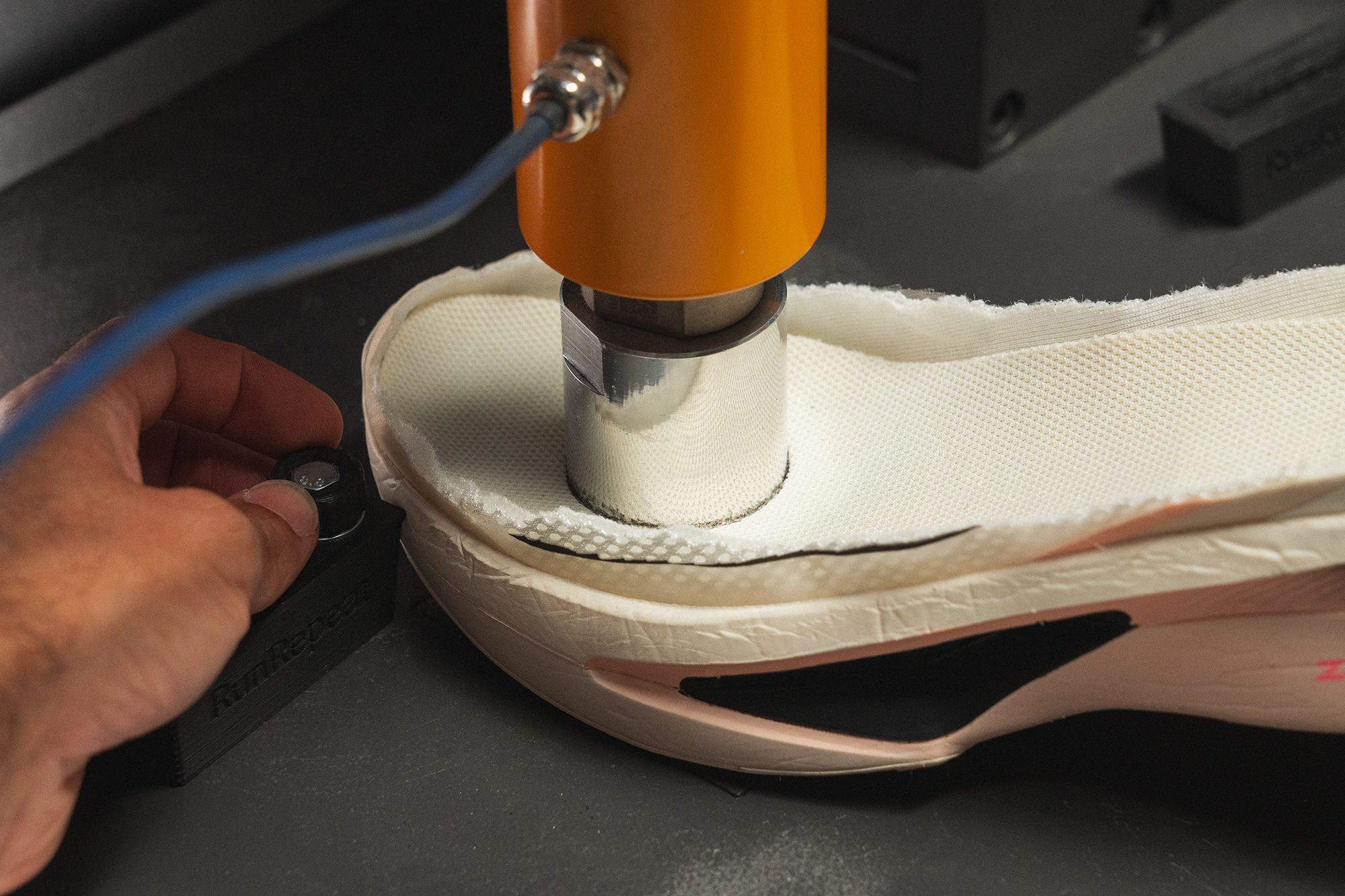
If you want the highest shock absorption possible, look no further:
Energy return in women's running shoes
While lower shock absorption makes sense for many women, energy return is a metric we all want to be on the higher end. This is because high energy return (and shock absorption) is related to the so-called leg-saving features. Basically, given that the shoe is doing some of the work so that we don't have to, our legs feel less tired. Who wouldn't want that?
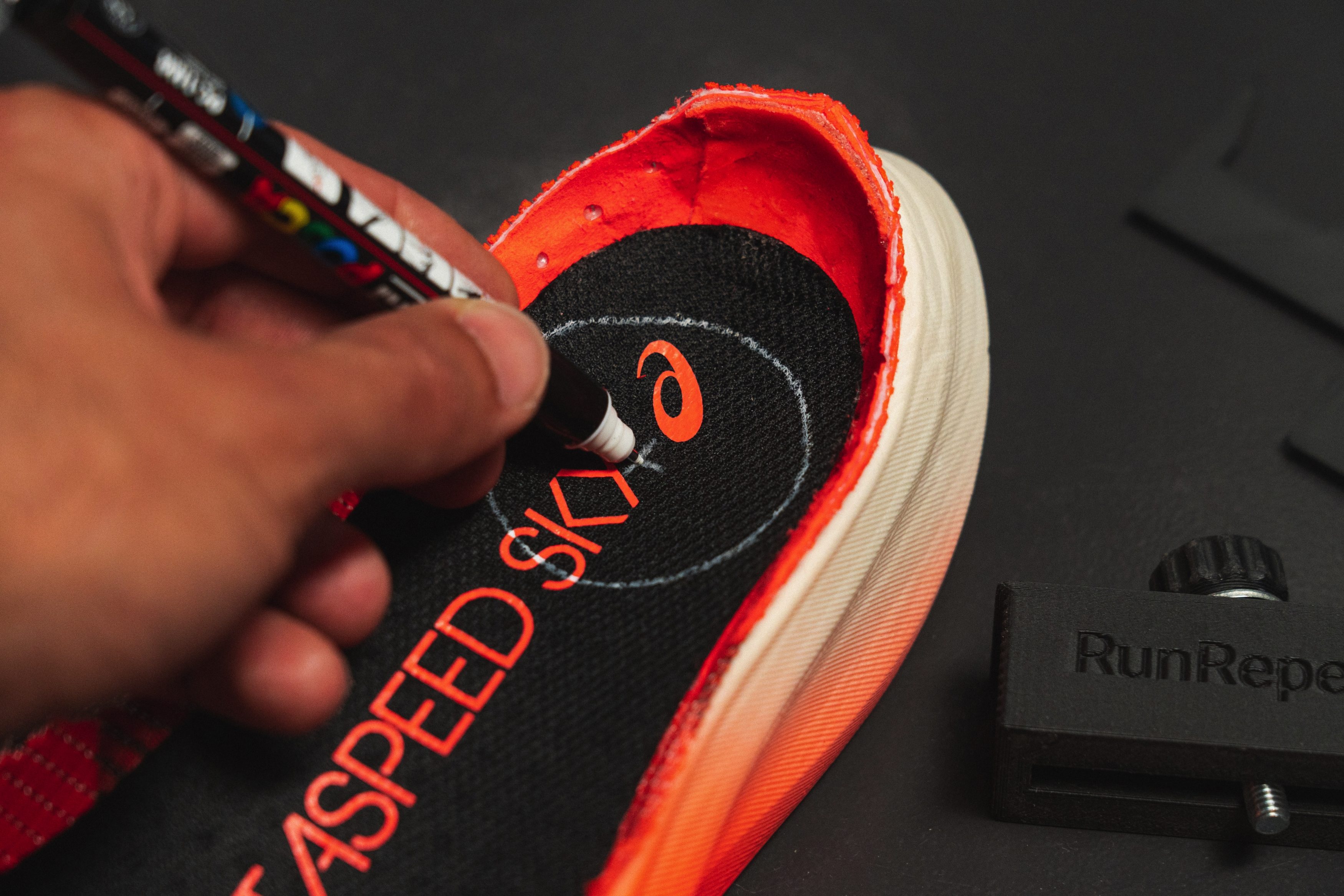
Of course, it's important to be realistic and take into account your needs. Daily trainers can't match the energy return of the expensive race-day shoes and that's OK. Our general recommendation is to avoid running shoes that bottom out and make you do noticeably more work!
Stack height in running shoes for women
Stack height varies, the more midsole you have below your feet, the less you’ll feel the ground and the more impact protection you’ll get. The downside of very high shoes is that they can be very unstable.
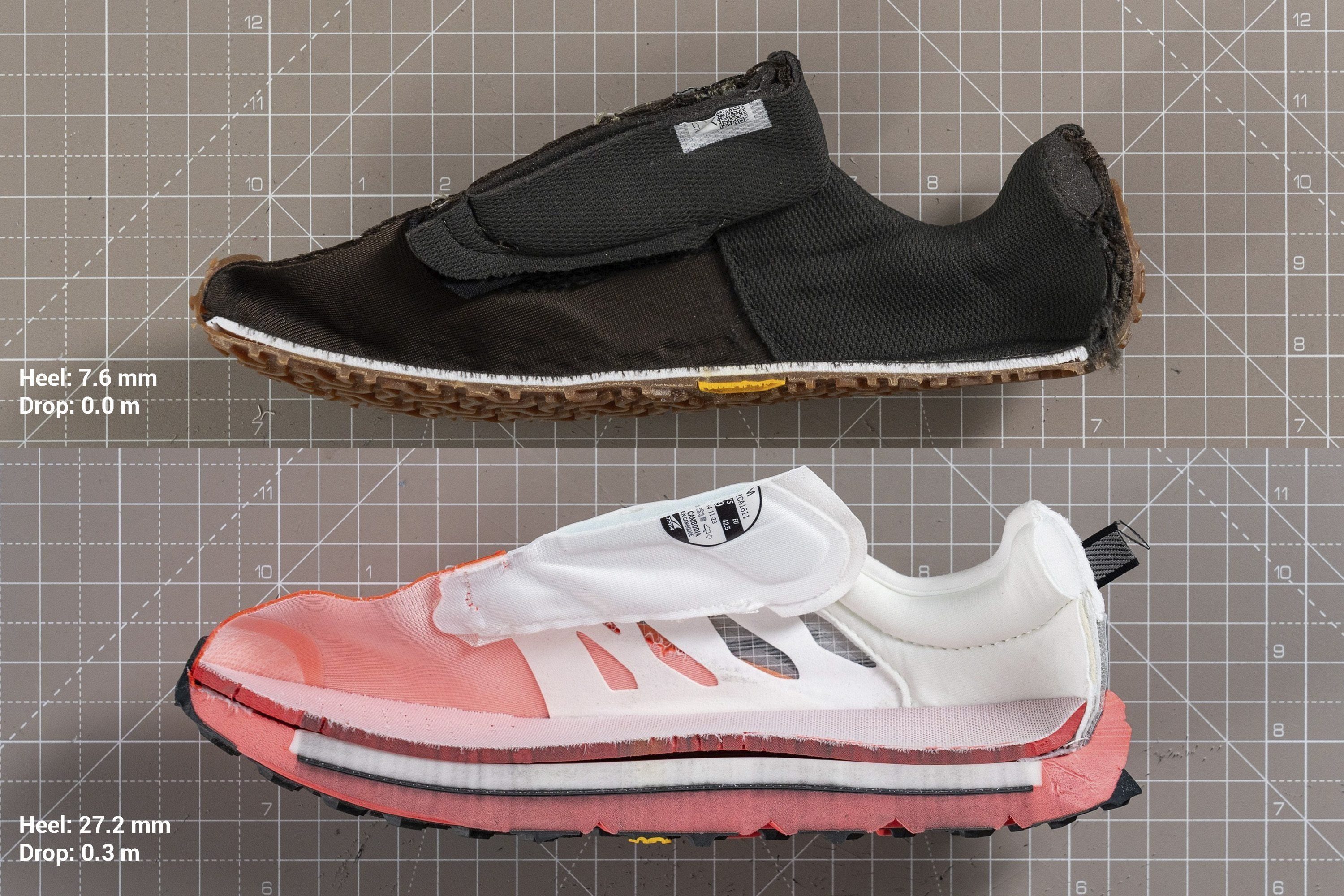
We recommend a heel stack height of 25-35mm for beginners. In our lab, we measure the stack heights according to the guidelines from WorldAthletics. This means we cut the shoes in half and measure the heel and forefoot stack height at the centre of the shoe, not a bit to the right or left.
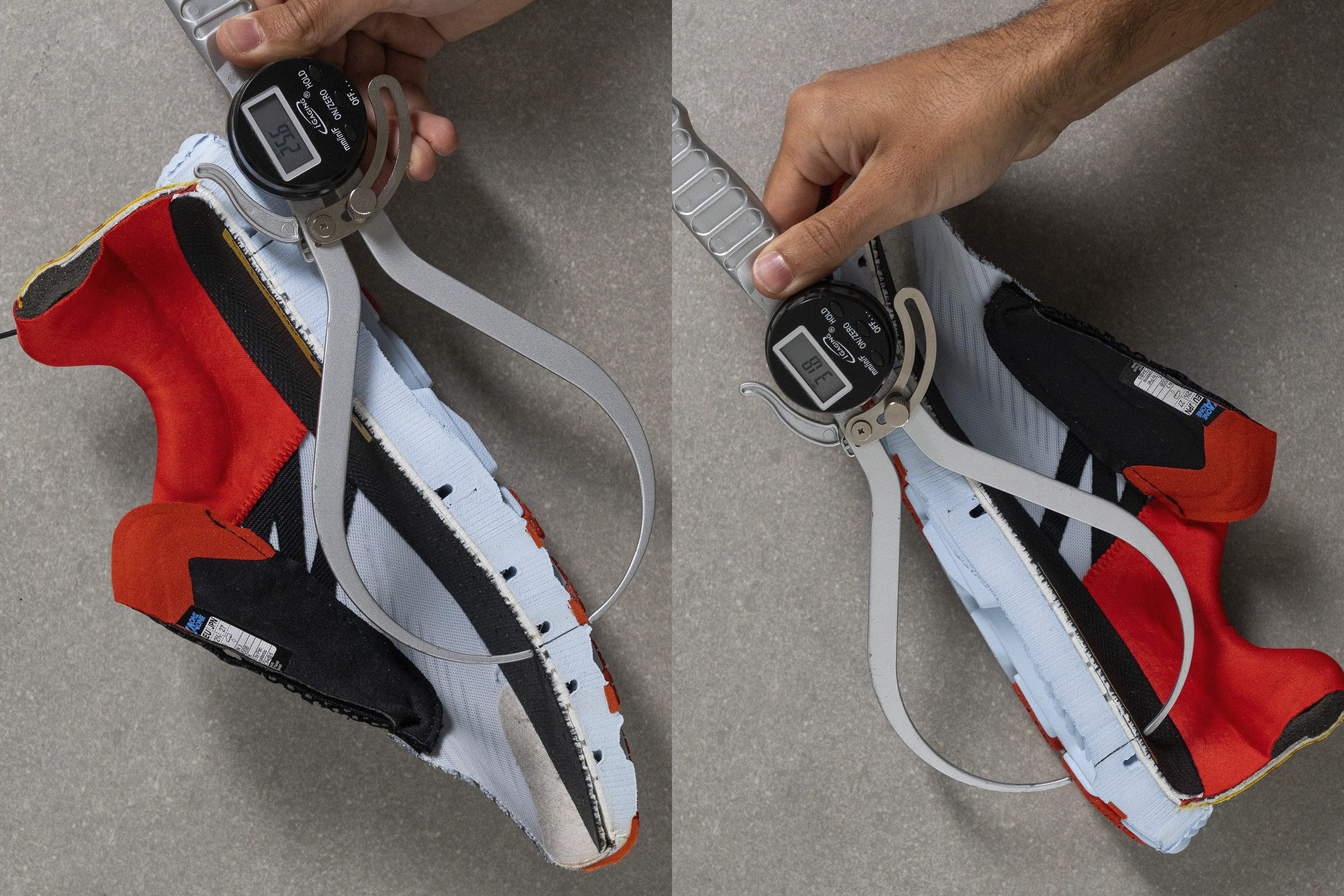
Heel stack height is measured at 12% of the inner shoe length, while the forefoot one is measured at 75% of the inner shoe length.
If you land on your heel, it’s best to look for a lot of cushioning in that area. If you’re a forefoot/midfoot striker, prioritise cushioning at the forefoot.
Heel-to-toe drop in women’s running shoes
Heel drop is the difference in height between the heel and the forefoot in running shoes. Like the stack heights, it’s given in millimetres.
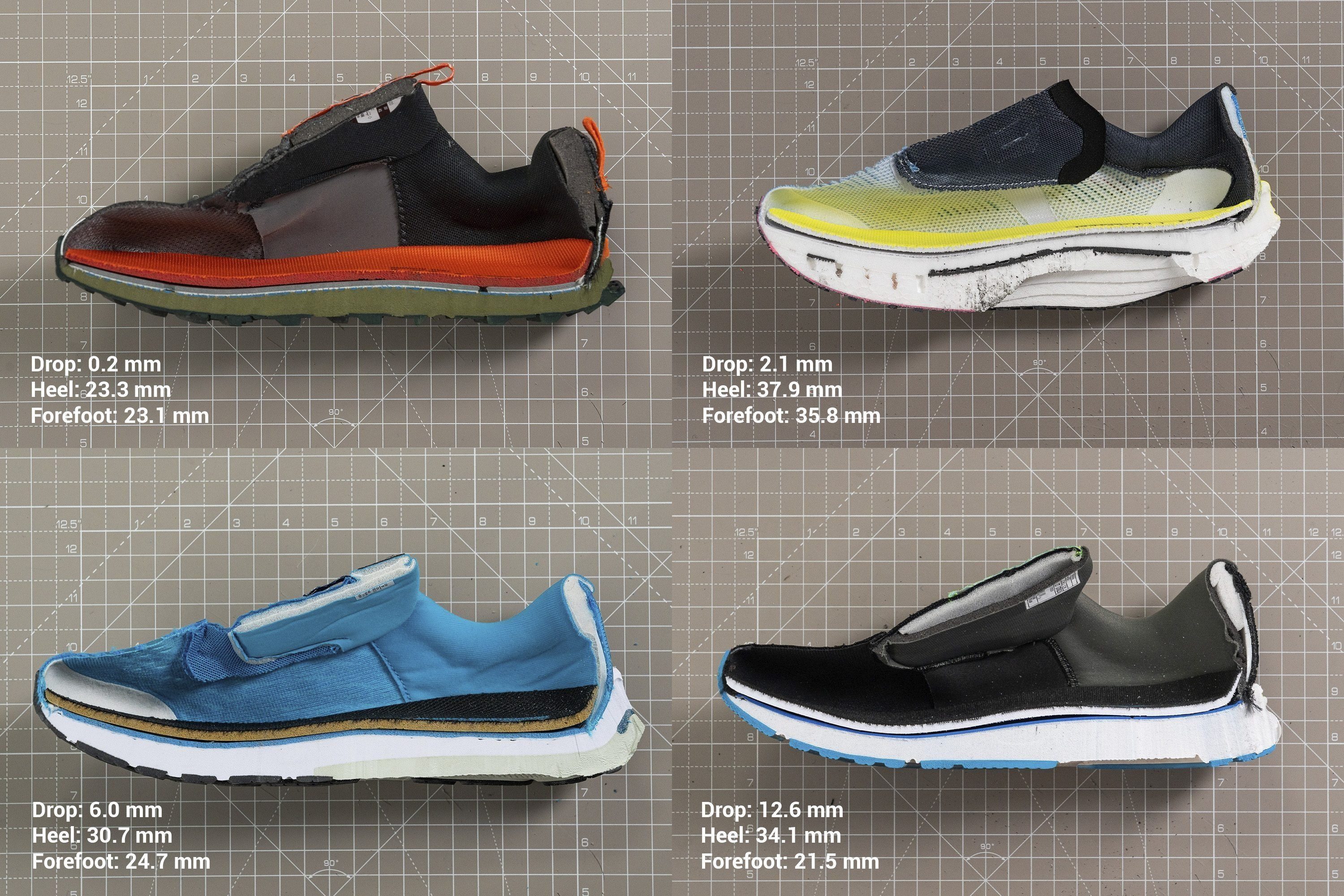
Women who just started running often don’t bother with heel drop and a general recommendation is to go with ~10mm heel drop in that case. However, it’s important to understand the effect of heel drop on our bodies and running.

There are 4 categories of heel drop and choosing one should be done based on your running experience and overall leg/muscle health:
- Zero-drop running shoes with a heel drop of 0 mm. These running shoes ask for the longest adaptation period because the majority of footwear is not zero-drop. We’re used to a higher drop. These shoes utilise your foot muscles the most. Experienced runners add them to their rotation to strengthen the foot muscles.
- Low-drop running shoes have a heel drop of 1-4 mm. These running shoes also ask for an adaptation period if you’re coming here from a 10mm drop. They utilise the lower leg muscles the most (Achilles, calves).
- Mid-drop running shoes with a heel drop of 5-8 mm. These shoes are quite frequent in trail shoes. They utilise higher leg muscles the most (thighs).
- High-drop running shoes have a heel drop of 9 mm or higher. Most of the running shoes have this heel drop and most of the runners are used to it. When coming from a zero drop to a 10mm drop, you can feel your hip muscles on fire.
|
We covered the topic of heel drop in the greatest detail in our Ultimate guide to heel to toe drop. |
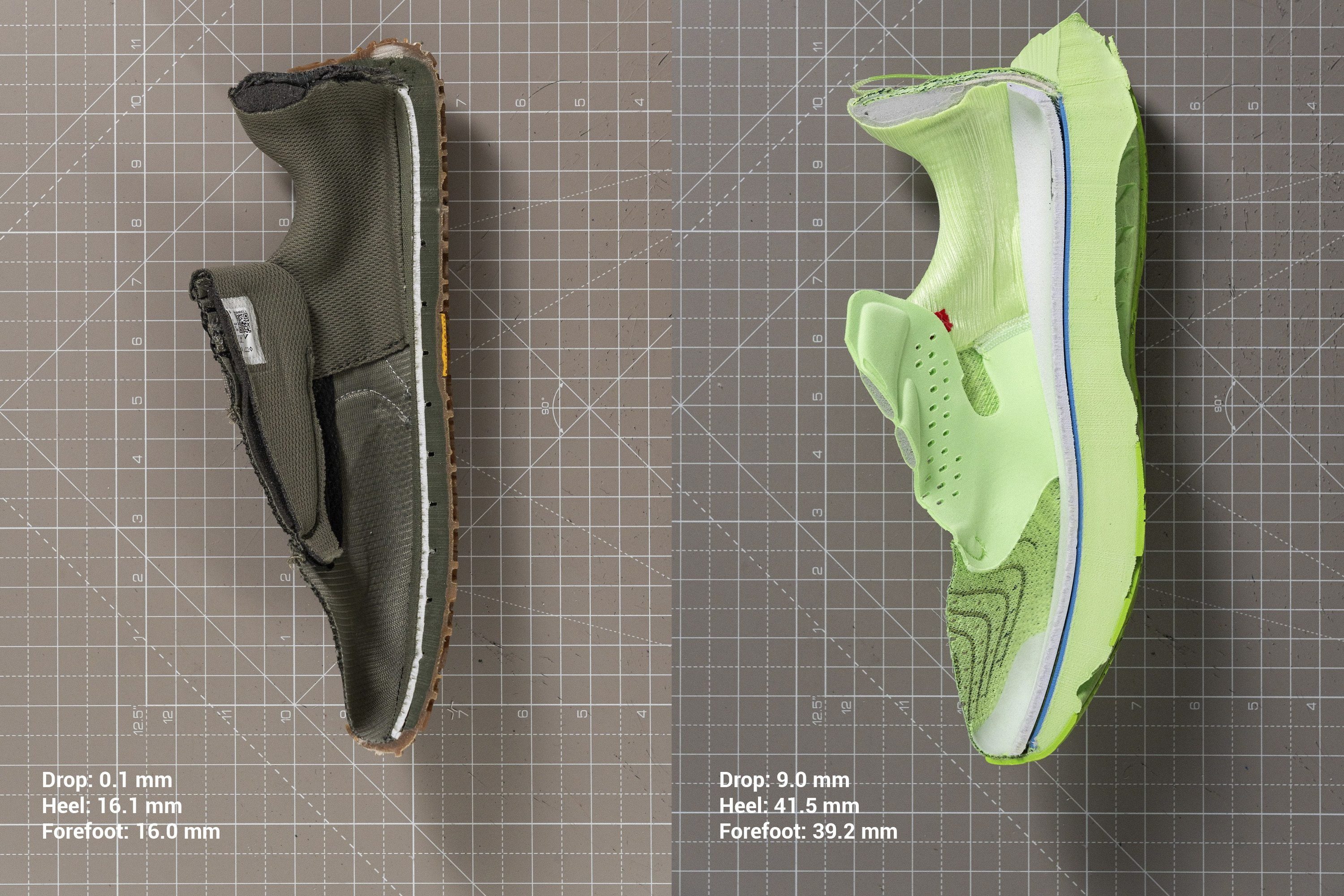
How soft are running shoes for women?
Most of us care about softness because we relate it to comfort. However, some women prefer running in firmer shoes because they feel more stable and supportive. Also, some foams can be too soft, meaning they allow your feet to sink in, but don’t push them back and forward.
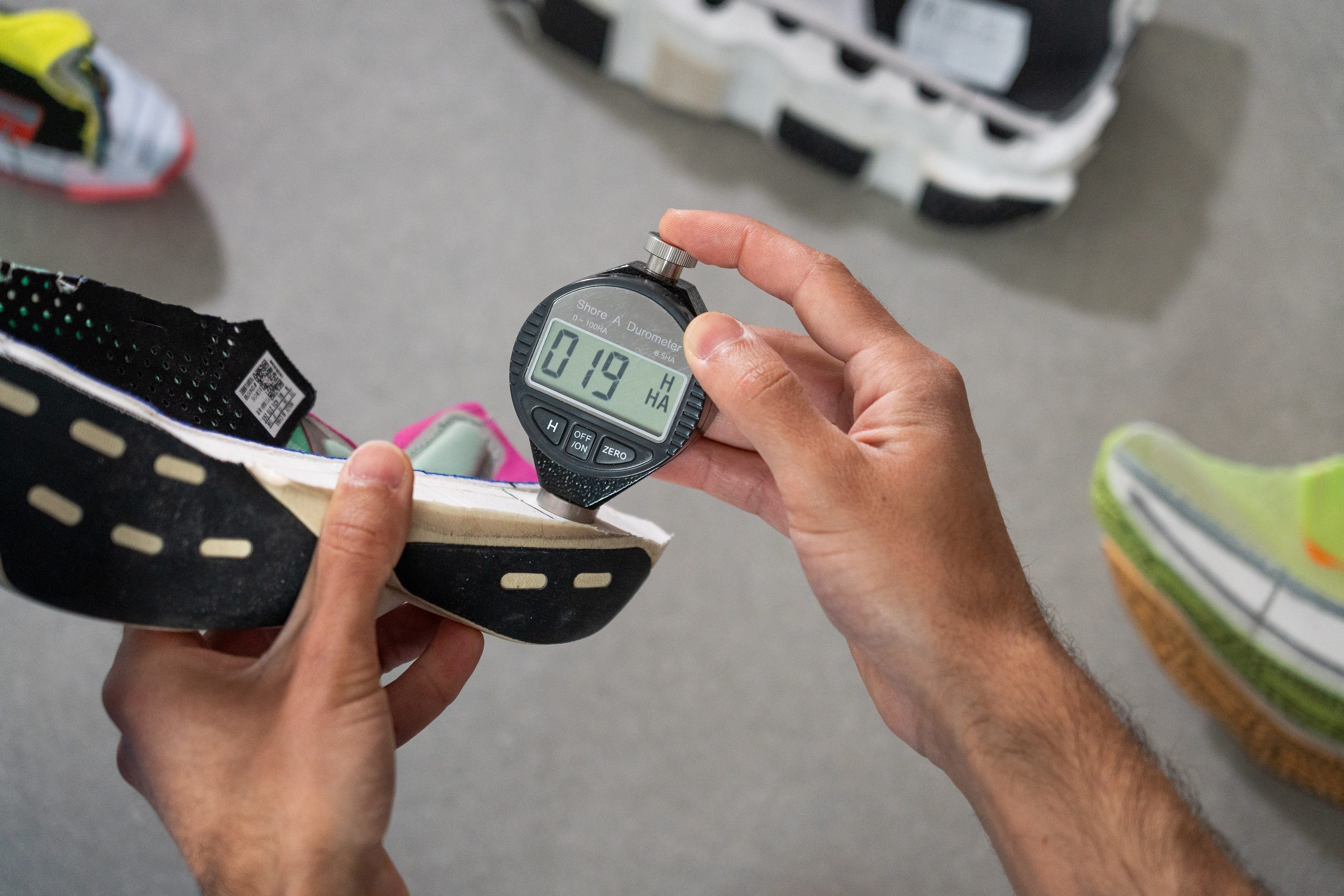
The only way to properly measure the softness of the midsole foam is to stick the durometer needle into it but once the shoe has been cut in half. Doing this on the outside (whole shoe) gives wrong results.
Looking at the numbers on the durometer, the lower they are, the softer the foam. For example, race shoes are 8.2% softer than daily trainers, according to our lab data.
For context, here’s how soft the best-rated running shoes for women are:
In case you want your ride to be as soft as possible, here are running shoes which got the lowest numbers on our durometer:
Responsiveness in women’s running shoes
Responsivness is THE feature to look for in competition running shoes. However, in daily trainers, it’s ok to sacrifice some responsiveness for durability and/or stability.
Premium running shoes usually feature premium foam. This foam has an insane energy return and leg-saving features but is very expensive and not durable. Standard foams, on the other hand, are usually found in daily trainers. They are much more affordable and more durable, but not as responsive.
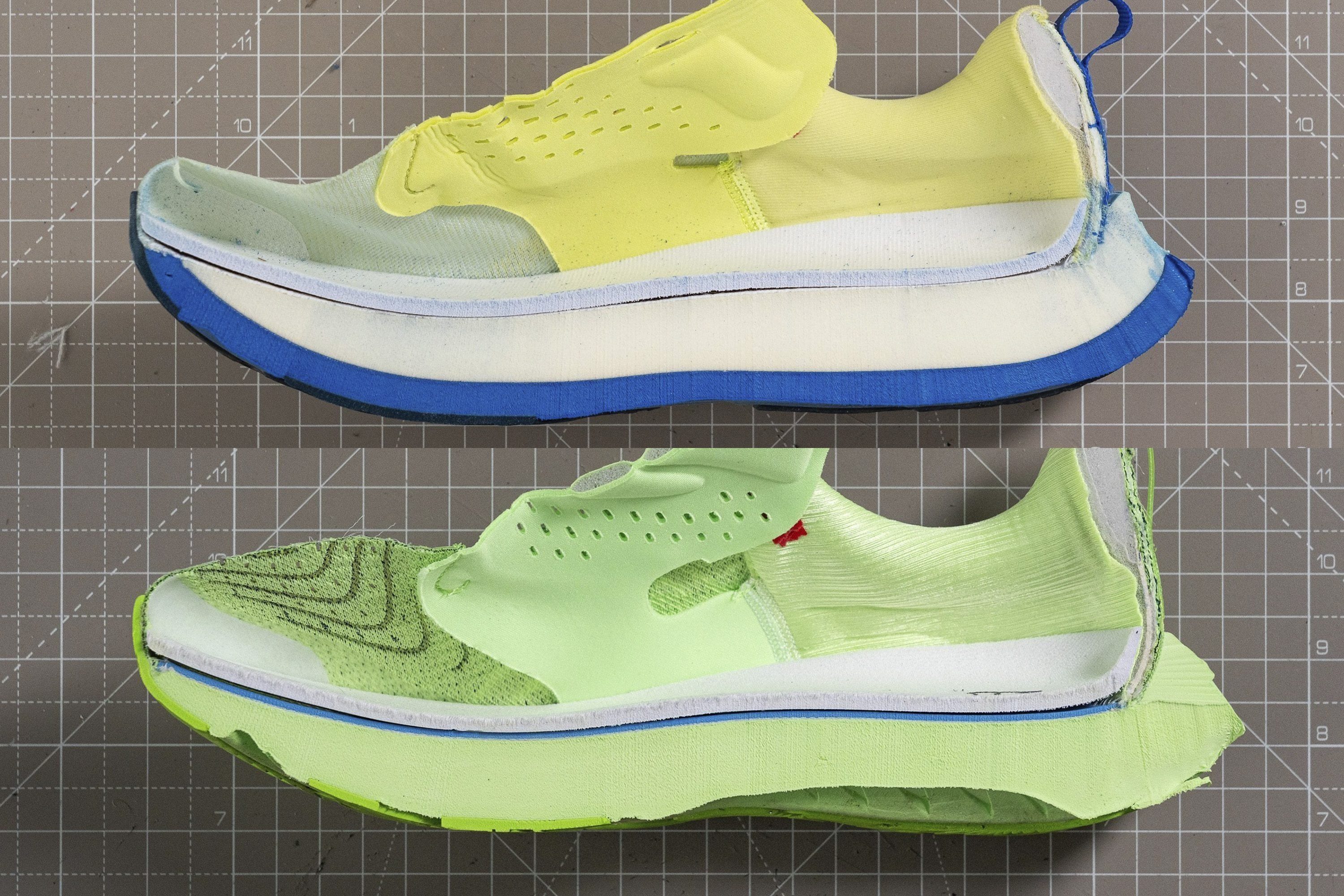
Just by looking at running shoes, it’s almost impossible to tell the difference between standard and premium foam
Our advice is to find your foam in the list of standard or premium foams and find out what you can expect from it!
Pros and cons of premium foams
| Brand | Foam | Top feature | Major drawback |
| Nike | ZoomX (Pebax) | Energy return | Durability |
| ASICS | FF Turbo (Nylon) | Durability | Weight |
| ASICS | FF Turbo+ (PEBA) | Performance | Stability |
| Adidas | Lightstrike Pro (TPEE) | Super-durable all-rounder | Break-in needed |
| Saucony | PWRRUN PB (Pebax) | Comfort | Energy return |
| Saucony | PWRRUN HG (Pebax) | Performance | Maybe too firm for some |
| Puma | Nitro Elite (PEBA + EVA / A-TPU) | Durability | Energy return |
| Hoka | Unnamed (PEBA) | Responsive | Impact protection |
| Decathlon | VFOAM (Pebax) / VFOAM PLUS (Pebax + EVA) | Affordable | Performance |
| Mizuno | Enerzy Lite+ (PEBA) | Bounce | Stability |
| Reebok | Floatride (Pebax) | Low price | Energy return |
| Li-Ning | BOOM (Pebax) | Bounce | Hard to find |
| On | Helion HF (Pebax) | Energy return | Durability |
| New Balance | FuelCell (Pebax) | Softness | Weight |
Pros and cons of standard foams
| Brand | Foam | Top Feature | Major drawback |
| New Balance | FuelCell (TPU / EVA) | Cloud-like feel | Stability |
| Skechers | HyperBurst (EVA) | Lightweight | Energy return |
| Skechers | HyperBurst Pro (TPU) | Responsive | Heavy |
| Nike | React / ReactX (TPE + EVA) | Versatile | Dull |
| Nike | Phylon / Cushlon (EVA) | All-rounder | Energy Return |
| Adidas | Boost (TPU) | Comfortable | Heavy |
| Adidas | Light Boost (TPU) | Weight | Boring |
| Adidas | Lightstrike (EVA / TPU) | Stability | Too firm |
| Adidas | Dreamstrike+ (Bio-based PEBA) | Versatile | Weight |
| ASICS | FF Blast / FF Blast+ (EVA + OBC) | Bounce | Durability |
| ASICS | FlyteFoam (EVA) | Lightweight | Energy return |
| Brooks | DNA Loft (EVA) / DNA Flash (EVA) | Lightweight | Dull |
| Brooks | DNA Amp (TPU) | Energy return | Heavy |
| Brooks | BioMoGo DNA (EVA) | Comfort | Energy return |
| New Balance | Fresh Foam / Fresh Foam X (EVA / EVA + PEBA) | Softness | Mushy |
| Merrell | Super Rebound Compound (EVA) | Durable | Energy return |
| Saucony | PWRRUN (EVA + TPU) | Versatile | Boring |
| Saucony | PWRRUN+ (TPU) | Energy return | Weight |
| Hoka | ProFly (EVA) | Comfortable | Energy return |
| Hoka | ProFly+ (EVA) | Responsive | Durability |
| On | Helion (EVA + OBC) | Unique | Firm |
| Altra | Ego (EVA) | Fun | Energy return |
| Altra | Ego Pro (TPE) | Bouncy | Cushion |
| Puma | Nitro (TPEE / PEBA) | Responsive | Durability |
| Puma | Profoam / Profoam Lite (EVA) | Durability | Cushion |
| Under Armour | HOVR (EVA + OBC) | Stability | Firm |
| Mizuno | Enerzy (TPE) | All-rounder | Bounce |
| Mizuno | Enerzy Core (TPE) | Softness | Durability |
| Mizuno | Enerzy Lite (Nylon) | Lightweight | Cushion |
| Mizuno | Enerzy NXT (EVA) | Soft | Stability |
| Salomon | EnergyFoam (EVA + OBC) | Stability | Boring |
| Salomon | EnergyCell / EnergyCell+ (EVA) | Durability | Firm |
| Reebok | FloatRide Energy (TPU) | Price | Heavy |
| TOPO | ZipFoam (EVA + TPU) | Energy Return | Heavy |
| Inov-8 | Powerflow Pro (EVA) | Comfort | Bounce |
Durability of women’s running shoes
Women who care about the durability of running shoes are usually the ones who already had bad experiences. Or maybe you just want to know what you’re investing in!
In our lab, we use a dremel to test the durability of 3 areas: toebox, heel padding, and outsole.
When we damage the toebox and the heel padding, we look at the damage and assign it a durability score on a 1-5 scale, 1 being the least durable and 5 being the most durable.
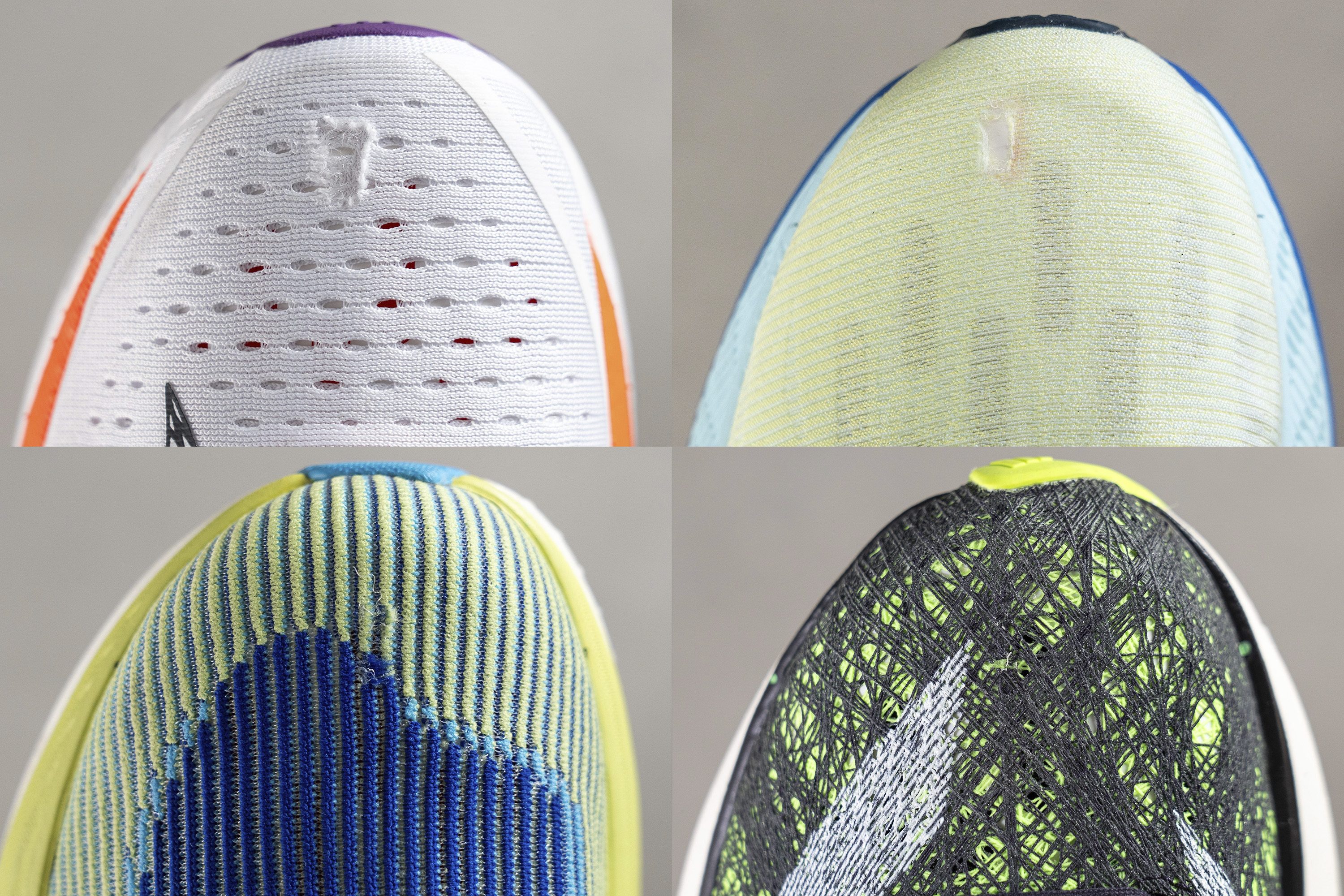
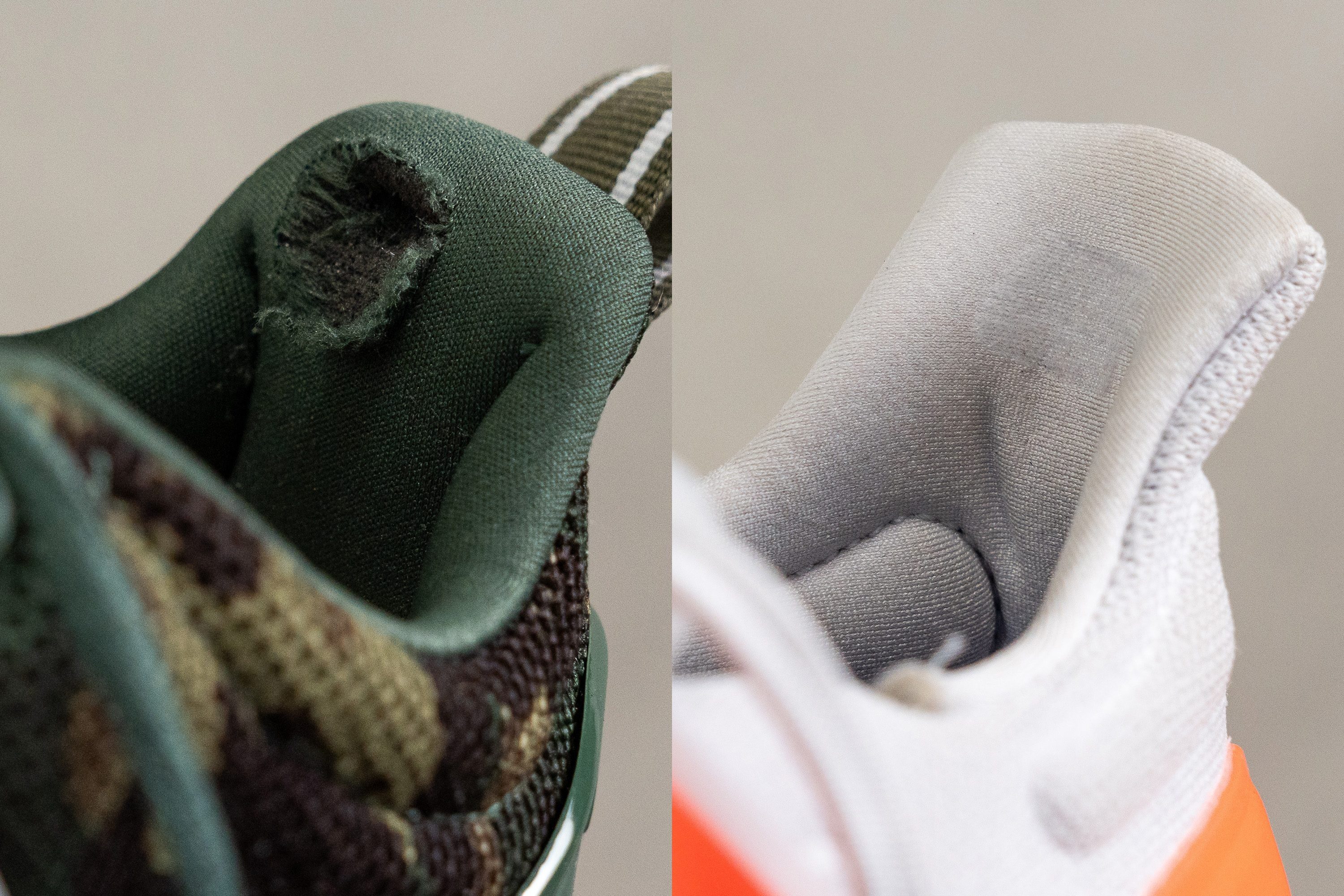
However, when we perform the same test on the outsole, given the nature of the material, we’re able to precisely measure the depth of the dent. So, we don’t need to assess anything.
We actually use a tyre tread gauge to measure the damage. It accurately measures the depth of the dent, so the deeper the dent, the less durable the outsole.

When it comes to the outsole durability, what also plays a part is the thickness, the more outsole you have, the more you can damage it, obviously.
Breathability of women’s running shoes
We use a smoke machine and a microscope to assess the breathability of running shoes.
Most women prefer very breathable shoes, which makes sense given that no one enjoys having sweaty feet. However, choosing those that don’t breathe (well) is a great decision for running in cold weather. When equipped with a waterproof membrane, it’s also great for wet weather!
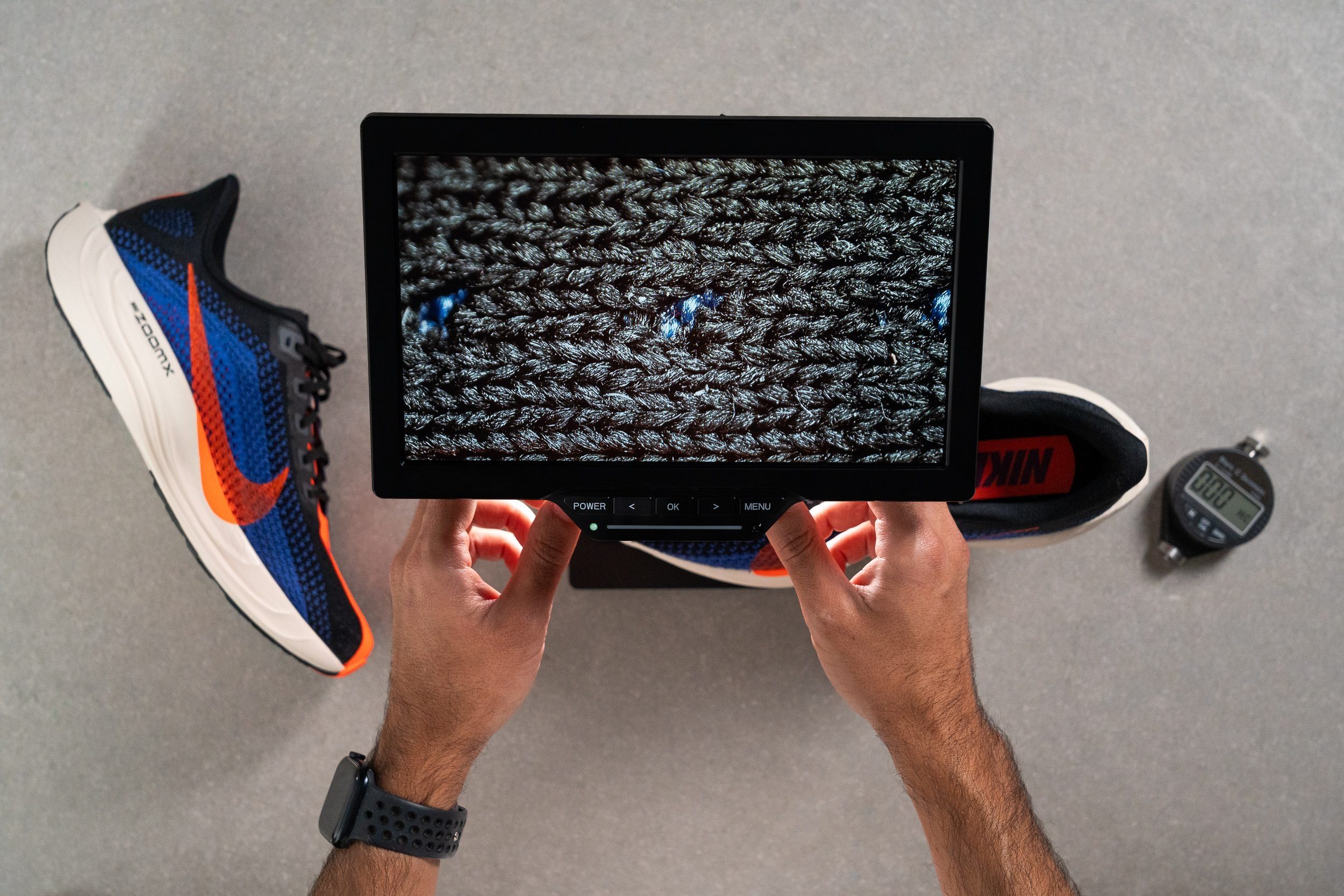
Looking at the upper under the microscope allows us to understand better why a shoe does (not) breathe. Very breathable running shoes have large ventilation holes, a 1-layer upper, loose structure. Non-breathable uppers have tightly packed threads, no ventilation holes, and often 2 layers.
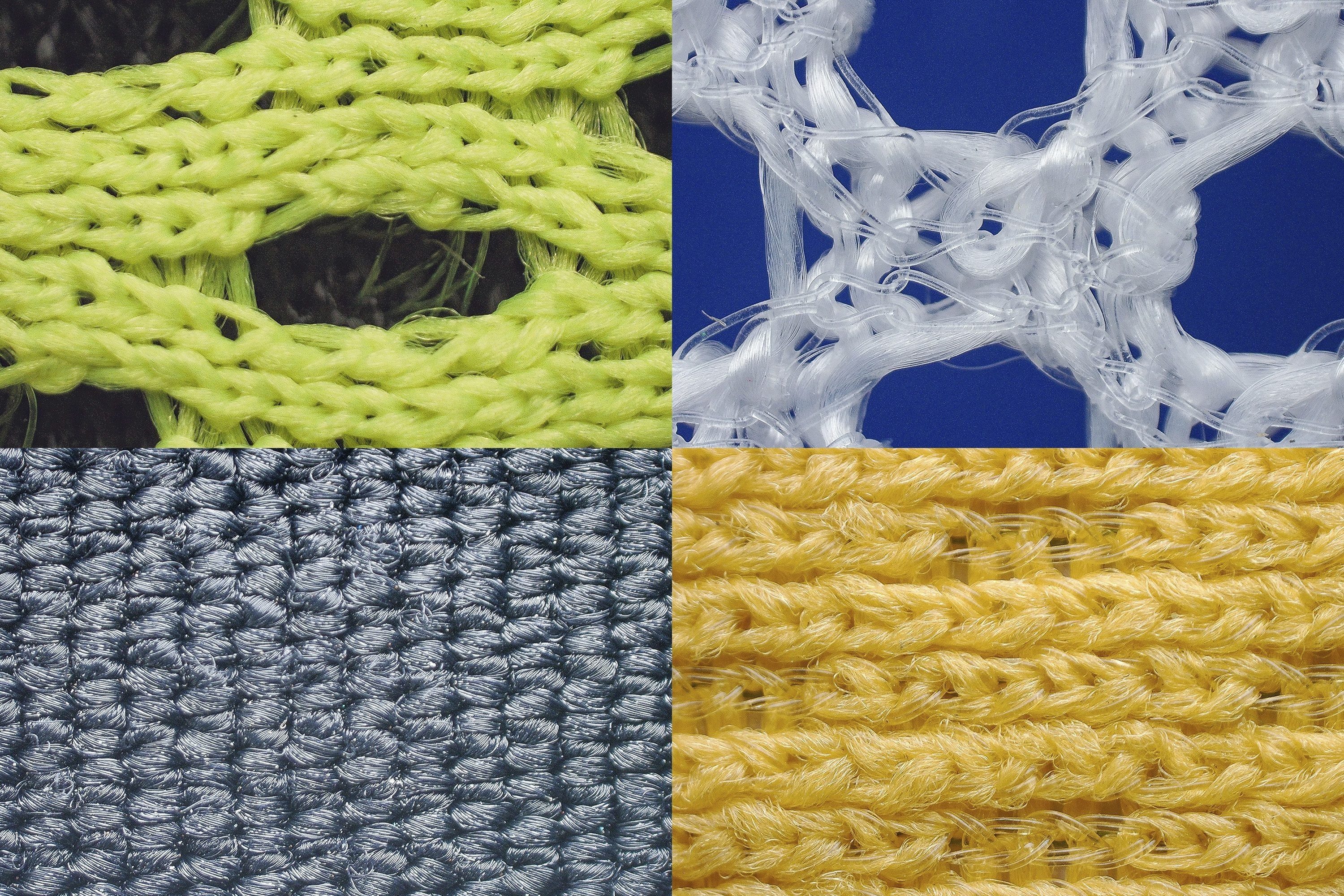
How to assess stability of women’s running shoes?
As mentioned in the stack height section above, higher shoes are great because they are easier on the legs with no ground feel and more foam to welcome your feet during the landing. However, high shoes can also be unstable.
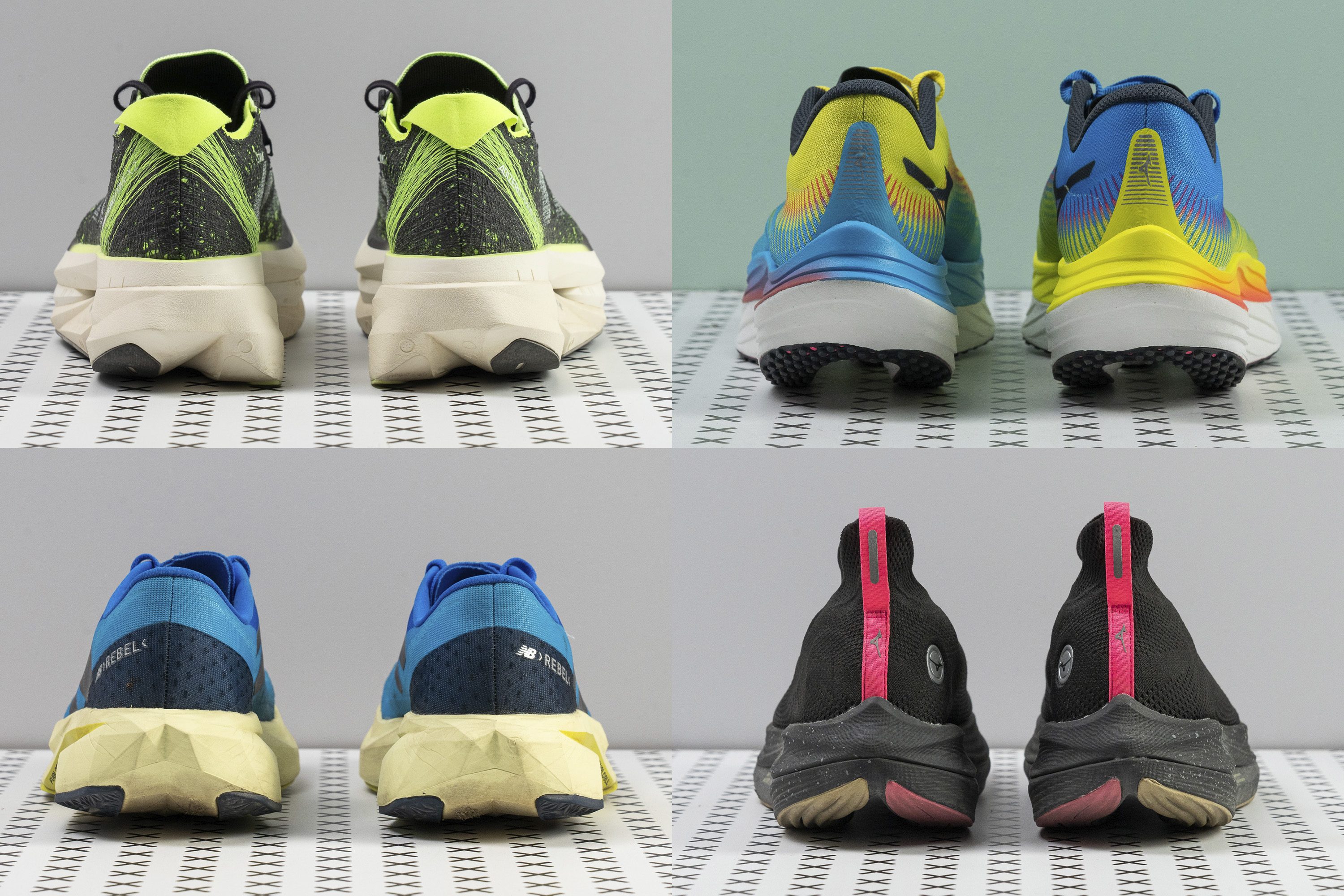
So, when we talk about the stability, we measure the platform width. The wider the midsole, the more planted the landing and toeoffs!
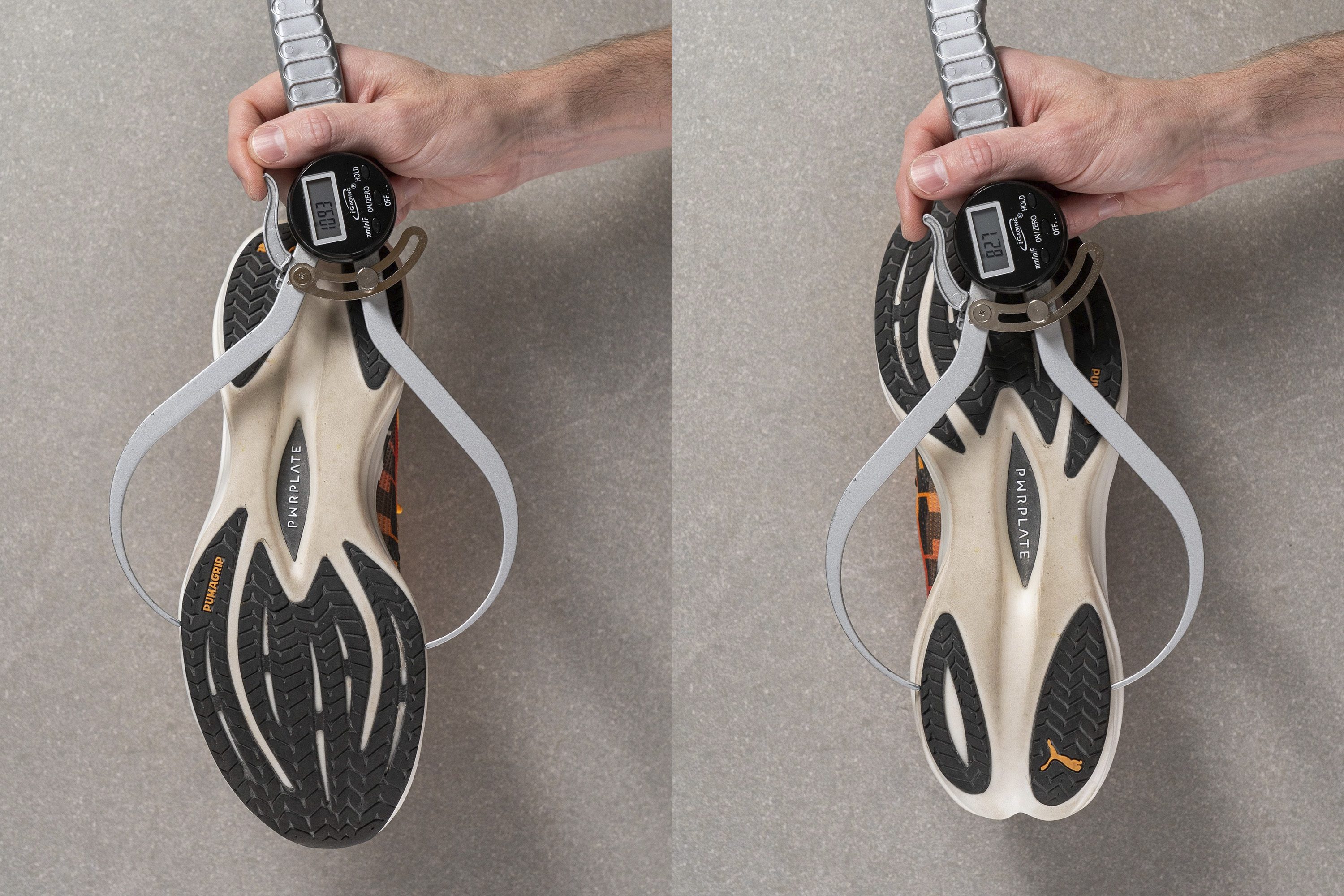
Wide toebox in women’s running shoes
While women’s shoes are, on average, narrower than men's, it does not mean some of us don’t need a wide toebox! For this reason, we measure the width of the shoe in 2 places. To do that, we have to make a gel mould of the shoe's interiors first.
After 2 hours in the fridge, the mould is ready and we can start measuring.
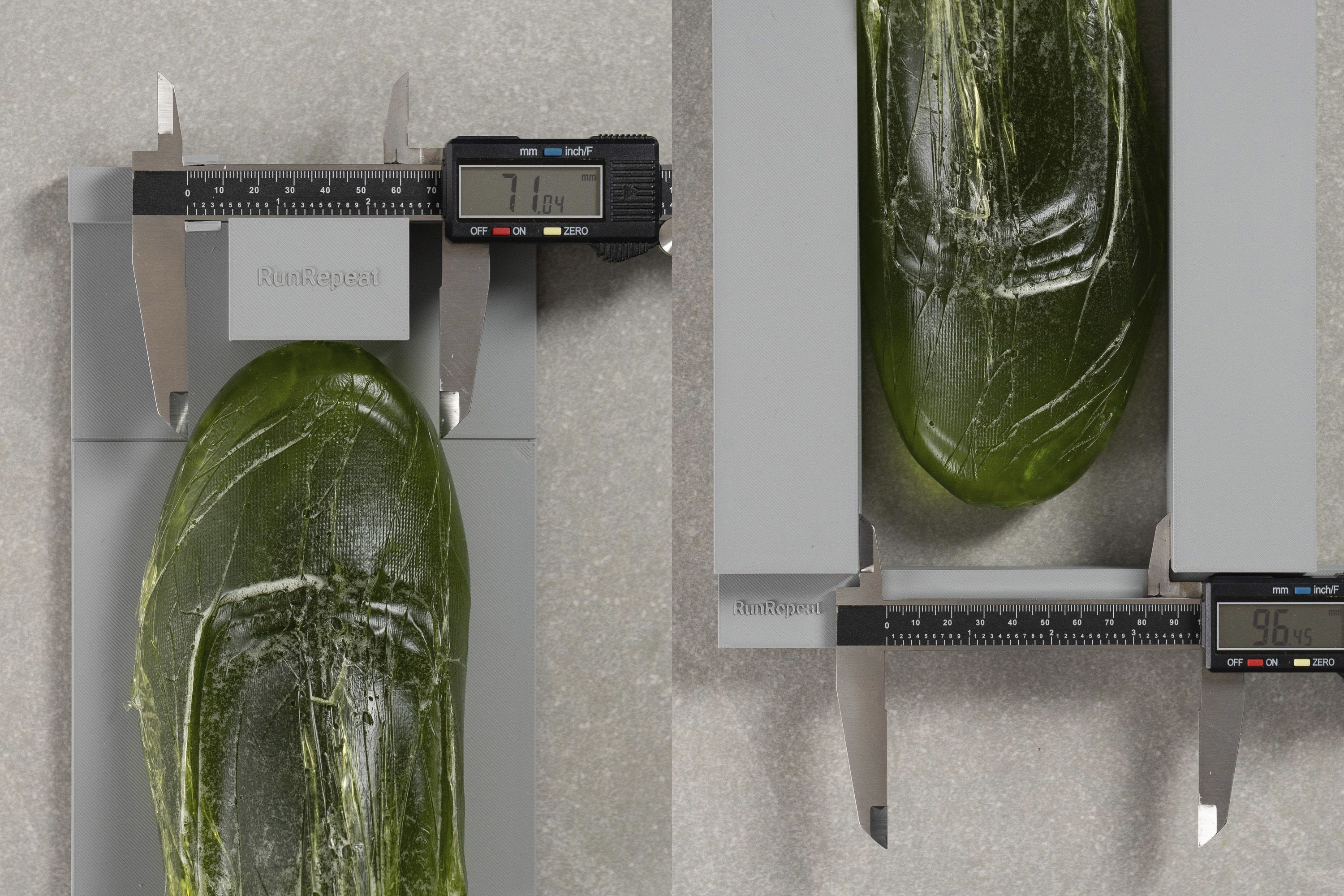
These 2 measurements allow us to understand not just how wide the shoe and the toebox overall are, but also how pointy the toebox is, or how much it tapers.

Women have differently-shaped toes, and that’s normal. So, one shoe shape can’t properly fit us all.

If you have pointy feet, look for a pointy toebox. If you have a wide forefoot, look for that! We list all our lab data points in our reviews so you can easily look for shoes within the same range or wider.
We also recommend reading our guide on Best running shoes with a wide toebox for more details, lab data, and advice!
And, while on this topic, it's also important to cover the toebox height. Some toeboxes are so low-volume that they even press on the toenails (from the top). If you've experienced this or maybe even dealt with black toenails, we recommend finding toeboxes with more vertical room.
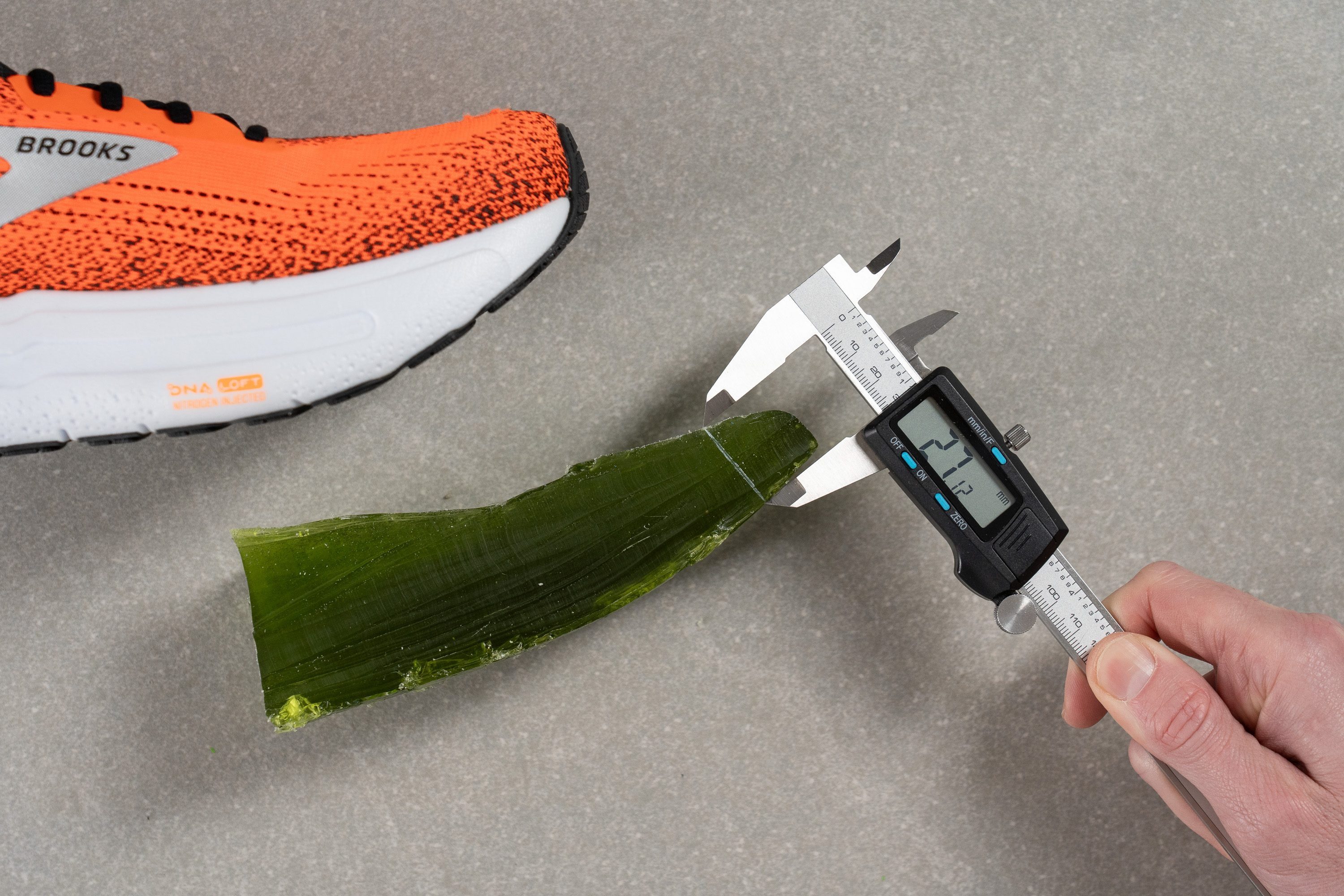
Pregnancy and running shoes: recommendations
When pregnant, women gain weight and their feet can swell. Here are features we recommend you look for in running shoes if you plan to use them as the pregnancy advances, maybe more as walking shoes than running shoes:
- Stability. Look for running shoes with a wider platform. Wobbling is a no in running not to mention when you’re carrying a child.
- Midsoles that feel stable and are not too soft. Firmer midsoles can be more stable and you should not feel like the shoes are tiring your feet (making them work extra).
- Perfect lockdown. This is a must for all runners but their feet might not swell as much. So, you need a shoe that will allow your feet to swell and yet fit perfectly, not too tight or too loose. Feet sliding to the sides and heel slipping are a no. Knit uppers are softer and have more give than the mesh uppers, but are also less breathable.
Trail running shoes for women
As mentioned above, the main difference between the road and trail shoes is the outsole. Trail running shoes have lugs. They also have more protection on the upper, the most noticeable being the toe bumper, and they feature (on average) a lower heel drop.
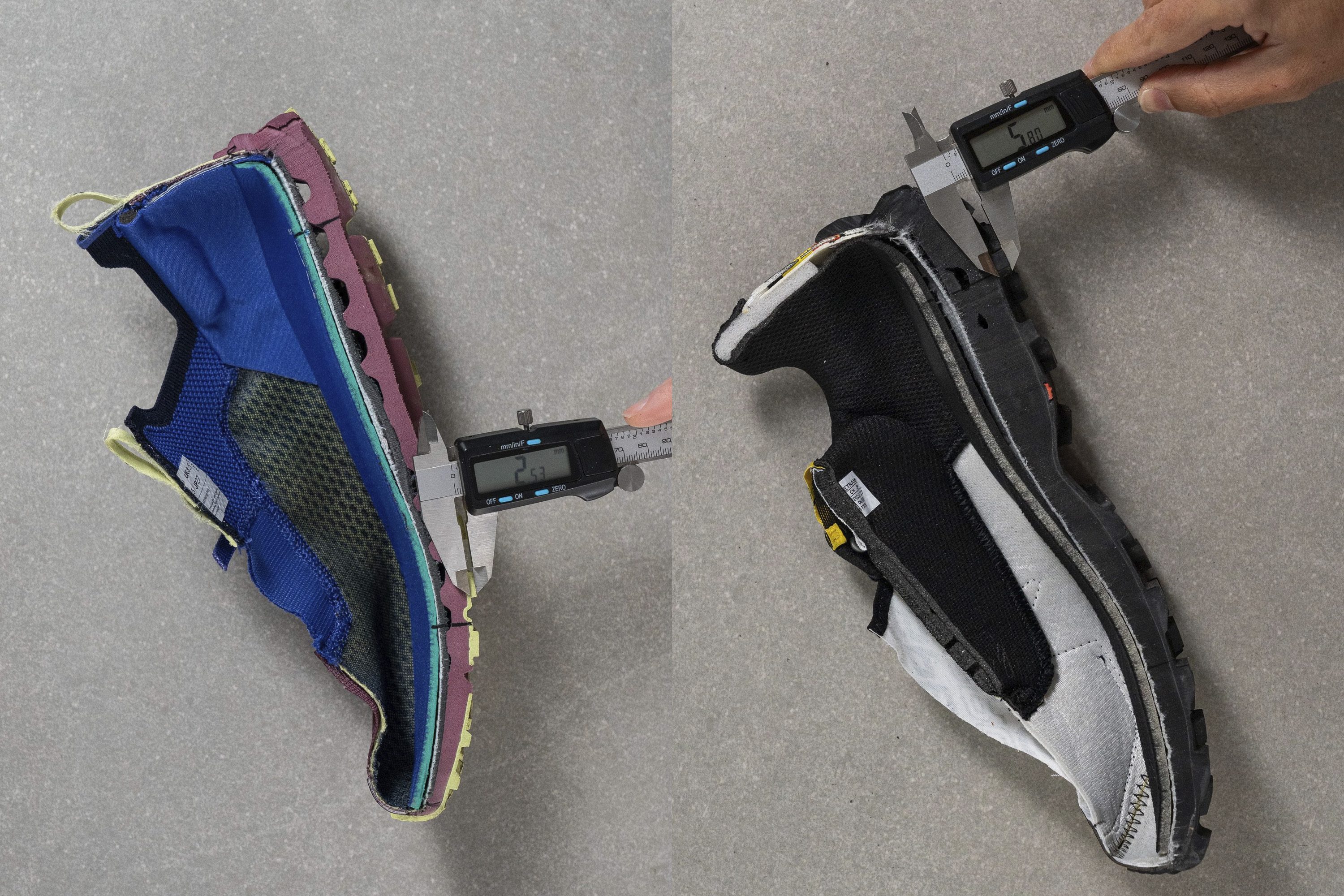
Basically, it’s all about the lugs when it comes to trail shoes. Very shallow lugs (less than 3 mm) are mostly used for light hiking and such lugs are found in hybrid shoes - those that we use both on roads and trails. Lugs that are 3-4 mm deep are mostly used on moderate terrain. And, finally, lugs deeper than 4mm are used for technical terrain.
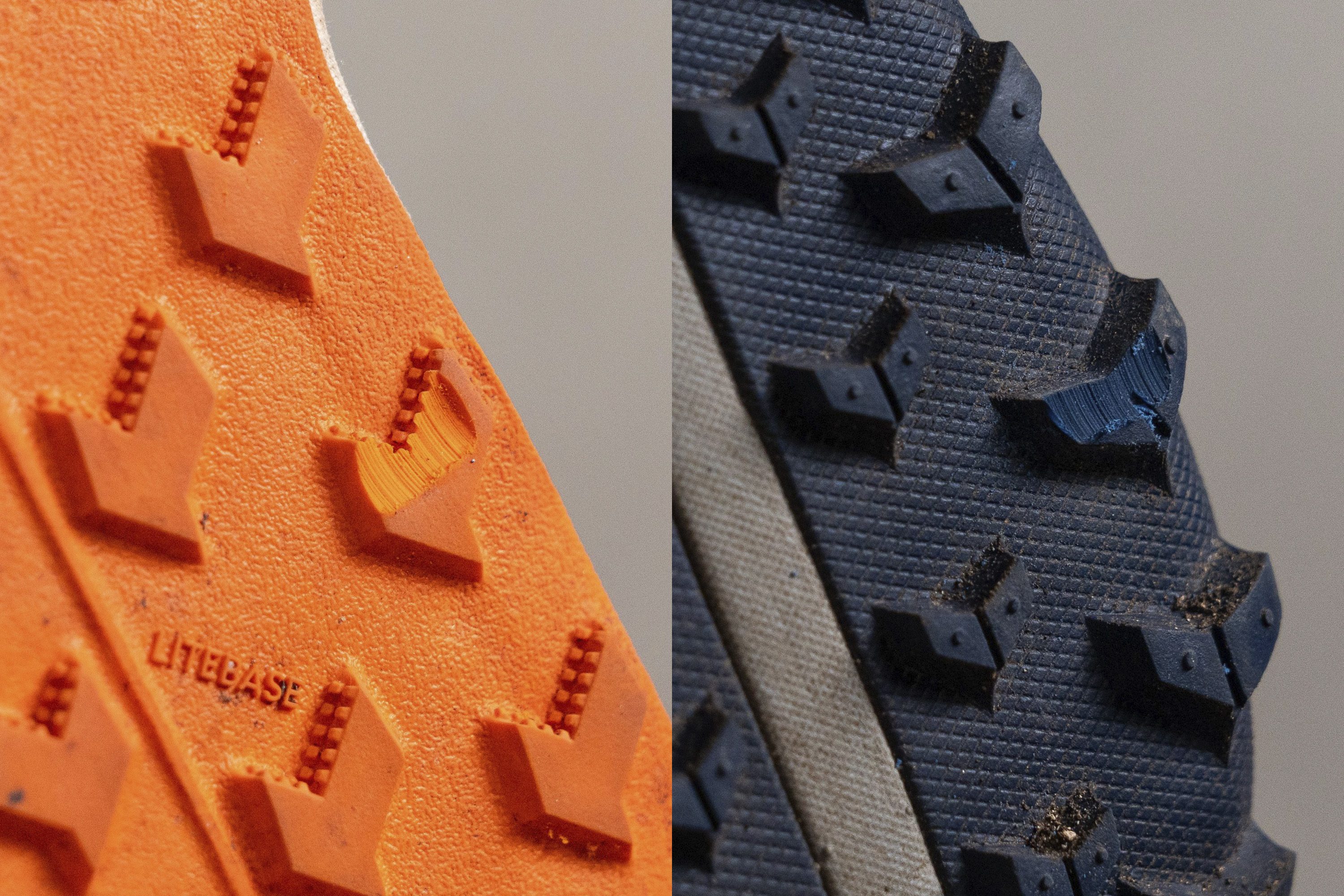
However, it’s not just about the depth. Their shape, orientation, and distance matter a lot.
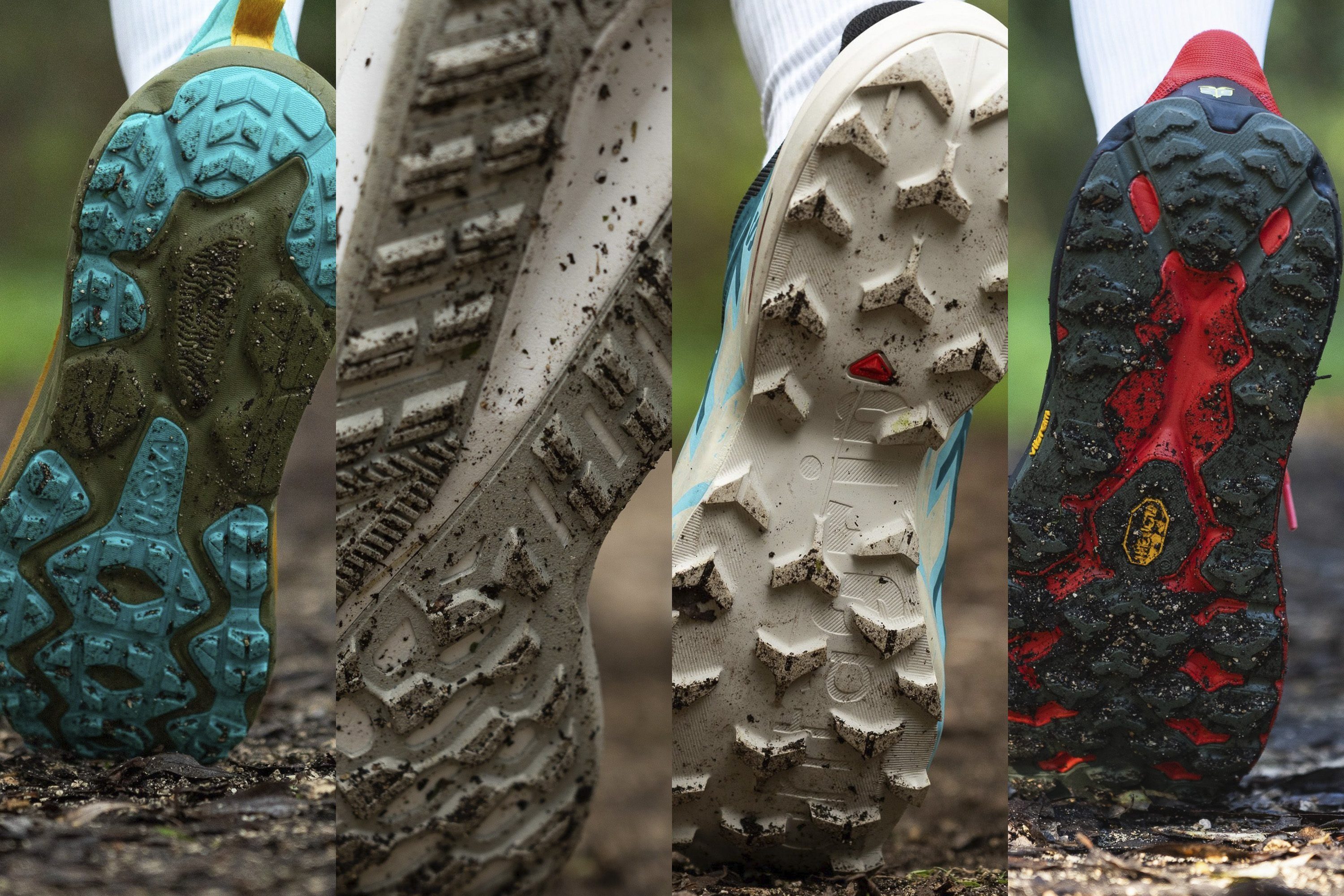
In the lab, we also measure the hardness of the outsole rubber. We do this because softer rubber is usually stickier so it can tell us more about the grip. On the other hand, harder rubber is more durable and protective.
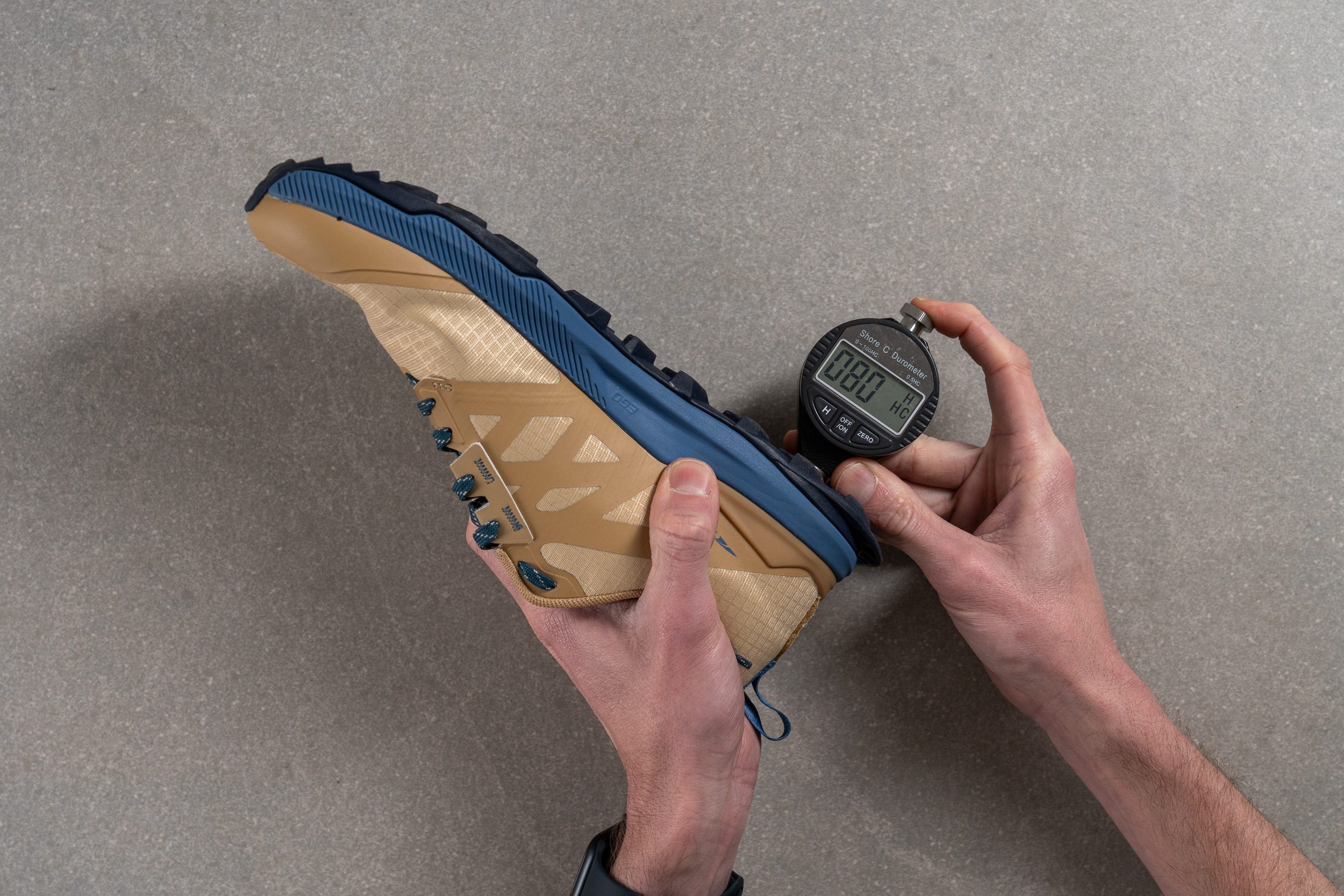
At the end, the design of the shoe can tell us a lot about the shoe’s purpose. Just because lugs are deep does not immediately qualify the shoe for mud or technical terrain. If it’s too unstable or too chunky, it won’t perform well on such surfaces.
Traction in running shoes for women
To test traction in women's running shoes, we honour SATRA TM144 testing methodology. We test traction in wet conditions because that's what we're worried about, how slippery the shoes are when it starts raining.
We use a 7-degree wedge and always apply the same force when pressing the shoe against the moving wet surface at the bottom. The result is the Dynamic Coefficient of Friction (or CoF) and, basically, the higher it is, the better!

